This episode was originally released in video form on the 3rd of December 2023 on the Cheecken YouTube channel, and later re-released with corrections on the MEGA Documentaries channel on the 4th of March 2024, it was first released in written form for Entropic Domain on the 13th of September 2024.
Disclaimer #
This article was written between September 2022 and December 2023, as a result, some details related to current events may be out of date at the time of release.
This is an independent production, it is not sponsored by any organisations: Governmental or non-governmental.
We have aimed to make this documentary as factual and accurate as possible, but it is not and does not claim to be unbiased or neutral, it represents a combination of evidence based research and our subjective personal opinions.
All sources used for the production will be cited throughout the article and in the Sources List.
Our use of an outlet as a source does not necessarily mean we agree with all of its views or contents.
0.0: Pre-Intro #
In 2022 we released our documentary, the Ukraine Narratives, covering the Russo-Ukrainian war, the second episode of our documentary series known as “MEGA”, at the time the documentary was made we expected that this would be a short conflict and we rushed to get the production out quickly, believing that soon enough Russian troops would be storming into Ukraine’s capital Kyiv, raising their flag and proclaiming victory, our thinking was that such a rapid explosion of conflict would create a lot of competing narratives and information warfare, and we sought to play our part in that conflict by examining media discussion surrounding the war, and explaining its background from various perspectives, sorting the misleading from the truthful.
Judging by the response we got, our Ukraine Narratives project was a success, commenters from around the conflict zone, those with families in Russia, Ukraine and Belarus, alongside general audiences, praised us for our “measured critique and analysis” and “complex conclusions”, and for being “honest and understanding”, safe to say it’s a production to be proud of.



But a lot has happened in the year since then, we originally planned to move on from Ukraine and look into new topics for the MEGA series believing that the war would be over shortly after the Ukraine Narratives released, when we made the Ukraine Narratives video we were rushing to get it out, believing that soon the whole topic would become out of date, with Russian troops marching into Kyiv and claiming a victory prize. But, like many in the early weeks of this conflict, we overestimated the Russians and underestimated the Ukrainians.
Instead of this war being a rapid Russian led blitzkrieg, it instead became a long, drawn out battle of attrition, because while the Russians had all their technology and weapons, superiority in seemingly every way, so did the Americans when they fought the Vietnamese, and we all know how that ended. Even in this day and age all the technology in the world can’t save you from the stubborn persistence of someone on their land.
Because of the continuation of the war, and the shift in its balance of power, we felt a need to go back to work, it’s important to examine the conflict and its context in more depth, and cover the events that have passed since our last report, necessitating a new production that can help people understand one of the biggest historical events at the start of this decade.
In other words, we have a lot of catching up to do, welcome to MEGA: The Ukrainian Divide.
0.1: Introduction - Explaining the Chapters #
You won’t need to have watched or read our previous report to understand this series, it is a sequel of sorts to that production, but it will go over the Ukraine conflict, the issues leading and relating to it, and discuss the motivations behind Russia’s decision making, this is our attempt to explain a year’s worth of war and the century or so of context behind it, the series spans a range of topics, some of which may interest you more than others.
This series can be read in a non linear manner, subjects can be skipped or read out of sequence and every topic is marked by chapters, subchapters are also attached to these which explain which issues or points in time are being discussed, so you can skip to what you want, or read everything in order.
Let’s begin with examining Ukraine’s formation as a country, the turmoil of the Second World War and the collapse of the Soviet Union, and how these things led Ukraine into the conflict we know of today.
Chapter 1. Buildup #
1.0: History - Leftovers from dead countries #
The story of how Ukraine’s politics managed to escalate into a full scale war only received a brief summary in our last documentary, 3 minutes or so of an over 50 minute long production. Now that the conflict is becoming more long term, it is important to understand its origins just as much as current events.
For this we have to go back over 100 years:
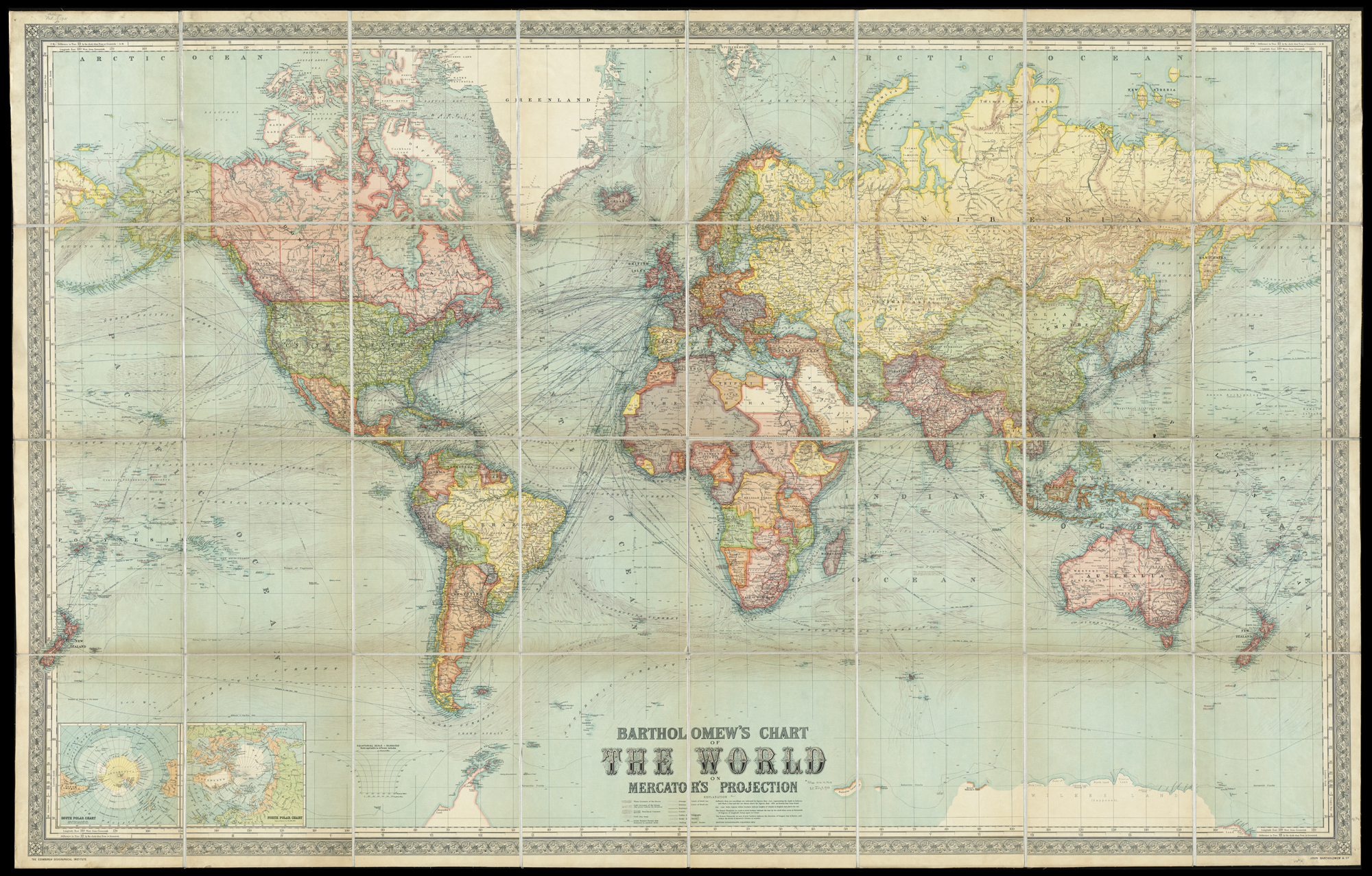
As you can see, the world was a very different looking place back then, lots of the countries we know of today don’t exist yet.
And there’s a problem.
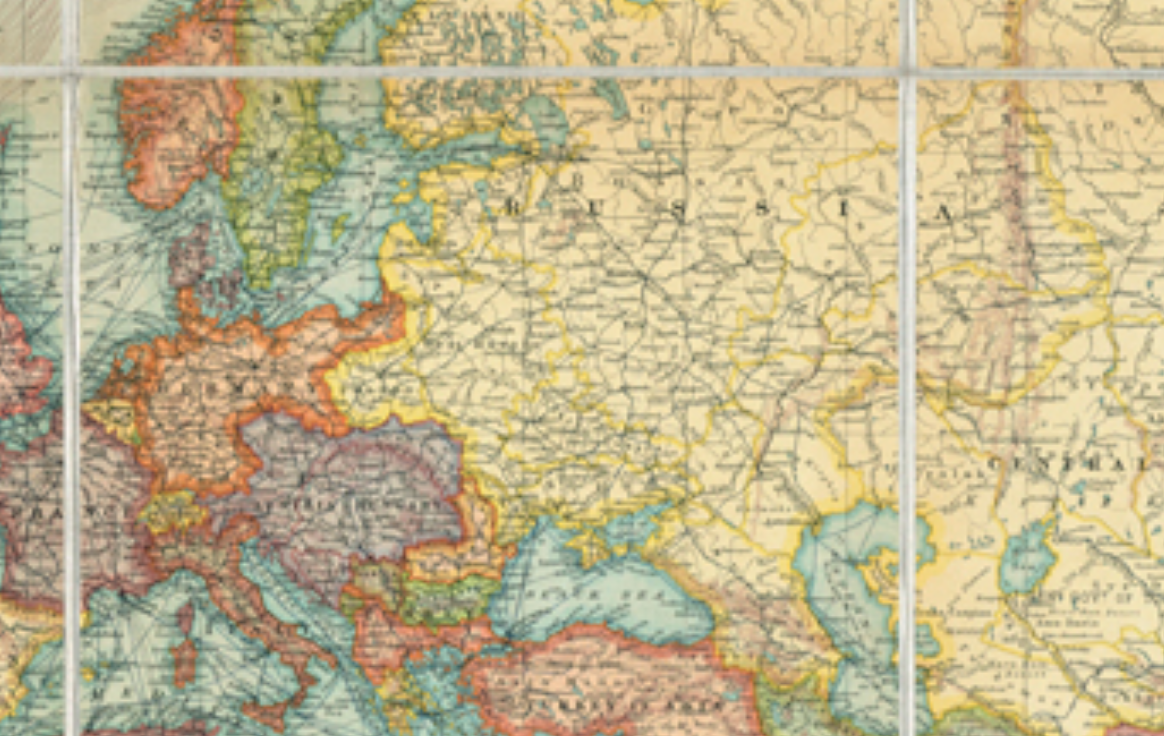
Ukraine isn’t here. That’s because it’s split between two empires, two countries: Russia, and Austria-Hungary.
You see, modern countries are built on two big ideas, self determination and territorial integrity. The first is the idea that a group of people, also known as a “nation” can decide for themselves what government, or “state” they want to be ruled under, this is called the “nation-state”, the second is that these states should have territories reserved for them, protected by borders that other states cannot violate.
But this concept is a modern one, a century ago it didn’t really exist, with much of the world being composed of seemingly random, messy, cobbled together kingdoms, ruled by old royal families.
Without self determination, weaker populations were often absorbed by the stronger ones with little power to retaliate, and so in the early 1900s Ukraine was occupied, for now.
The countries that ruled what is now Ukraine were stuck in the middle of the First World War, known at the time as the Great War. Austria-Hungary was fighting for a German-led alliance called the Central Powers, while Russia was fighting for a British and French-led alliance called the Triple Entente, or more simply known as “the Allies”.
Austria-Hungary was fairly small compared to some of its neighbours, but you can’t say the same for the Russian Empire, a country that comprised around one sixth of the entire planet, containing not just modern day Russia, but also numerous other territories in Central Europe, Asia and huge portions of Eastern Europe, including most of Ukraine; All of this was Russia until 1917 when everything started to unravel.
1.1: History - Ukraine in Russia #
Russia was essentially the only Allied country fighting on the war’s Eastern Front and it wasn’t going well for them, the Russian troops found themselves in a stalemate with the Central Powers, Russia’s economy was essentially dead and the Russian population were starving, growing tired of sacrificing their lives for a conflict they didn’t feel was worthwhile, rebellion mounted against the Empire.
In March 1917 the Russian Empire was overthrown by the February Revolution, with the aftermath being a situation known as “Dual Power”, where control over Russia was split between a new Provisional Government and the Soviets, a set of militant Communist run worker’s councils spread across the country, it was in this chaos that modern Ukraine first emerged.
In response to the political crisis in the rest of Russia a Ukrainian political group known as the Central Rada of Ukraine was founded and declared the “Ukrainian People’s Republic”, an autonomous part of Russia with its own identity, the legitimacy of the UPR was eventually recognised by the Provisional Russian government, which later reorganised itself as the Russian Republic.
But in November 1917 Russia was plunged into disorder again by the October Revolution, where the Communists overthrew the Republic and declared their own government, the Russian Soviet Federative Socialist Republic, leading to a civil war between the Communists, who became known as the “Red Russians”, and the “White Russians”, Anti Communists made up of those hoping to either restore either the Russian Empire or the Russian Republic. The White Russians didn’t recognise Ukraine as a separate territory, considering it a part of “Southern Russia”, but the Reds did, and formed the Communist aligned Soviet Republic of Ukraine, a state that they eventually hoped could take over the UPR.
[Editor’s Note: The months are wrong for these event names because Russia used a different calendar to the modern one at the time (the Julian Calendar instead of the current Gregorian calendar), which is why the February Revolution was in March and the October Revolution in November]
Once again the UPR responded to the crisis, this time declaring full independence from Russia in January 1918, and in February of that year their independence was recognised by the Central Powers, who signed a treaty with the UPR known as the Treaty of Brest-Litovsk where the Ukrainians agreed to end their role in the war effort.
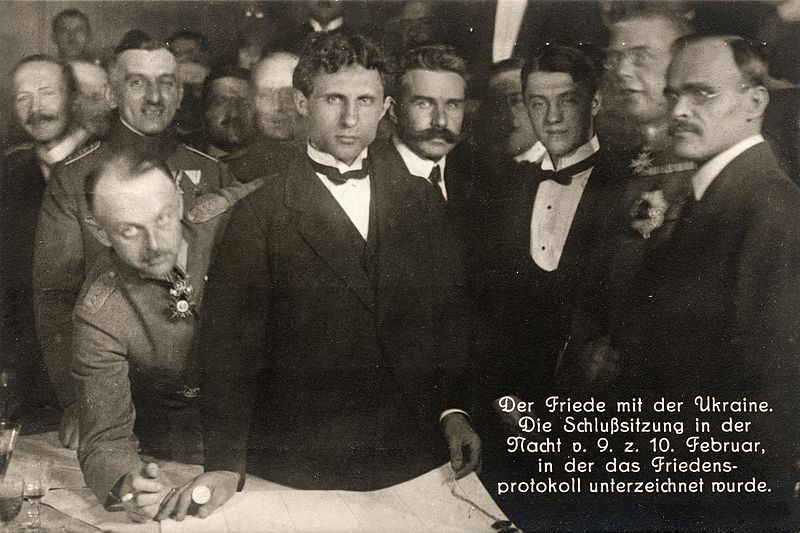
In March their independence was also recognised by Soviet Russia, as the Communists signed their own treaty with the Central Powers under the same name, part of the treaty was that the Russian Communists agreed to give up their claims to Russia’s former imperial territories, Ukraine included, and hand them over to the Central Powers, giving them total victory on the Eastern Front and leading to Allied reprisals across Russia and its former territories.
This resulted in most of Ukraine falling under an occupation from the Central Powers, with the Ukrainian People’s Republic being briefly abolished and replaced by a Pro-German proxy called the “Ukrainian State”. Smaller portions of Ukraine were invaded by the French led Allies in response.
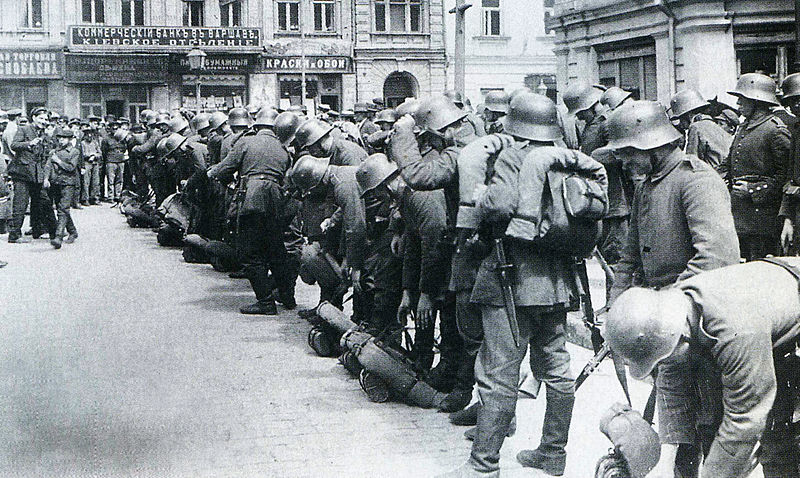
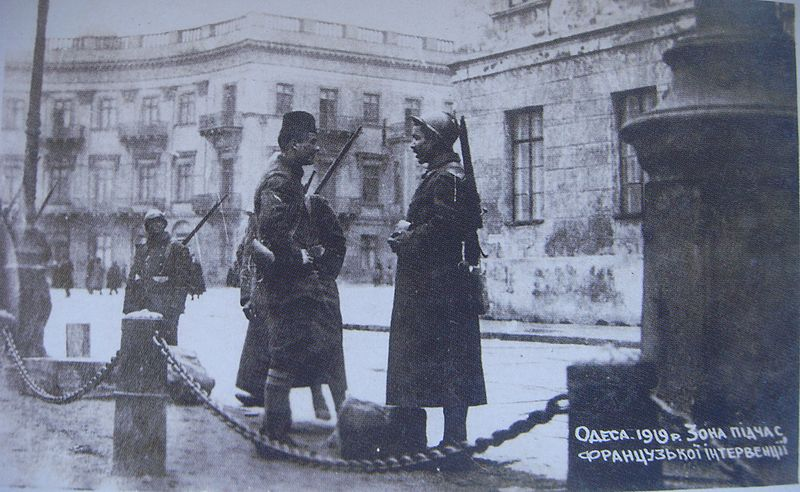
But 1918 was the last year of the First World War, and all sides of the conflict were exhausted, riddled with disease and losing millions of citizens to the fighting. While the Eastern Front was a great success for the Central Powers, the Western Front was not, bringing members of the Central Powers like Austria-Hungary into disrepair.
1.2: History - Ukraine in Austria #
While the Austro-Hungarian Empire was dwarfed by Russia it still controlled large portions of Europe; What the Russian Empire was to Europe’s East, Austria-Hungary was to its centre, the Austro-Hungarians had lasted longer than the Russians did, but like the Russians they were being brought towards disaster by the war.
In October 1918 the Hungarians decided to leave the Empire and form their own republic, spelling the end for Austria-Hungary and leaving the Empire’s scattered territories to decide for themselves what nations to join or build. The remnants were achieving self determination!
But with little experience in nation building, they weren’t able to form nationalistic ties through shared values, a kind of “civic nationalism”, instead relying on the abstract concepts of blood and race, “ethno-nationalism”, demanding a “Hungary for the Hungarians” a “Poland for the Polish”, a “Romania for the Romanians”, and so on.
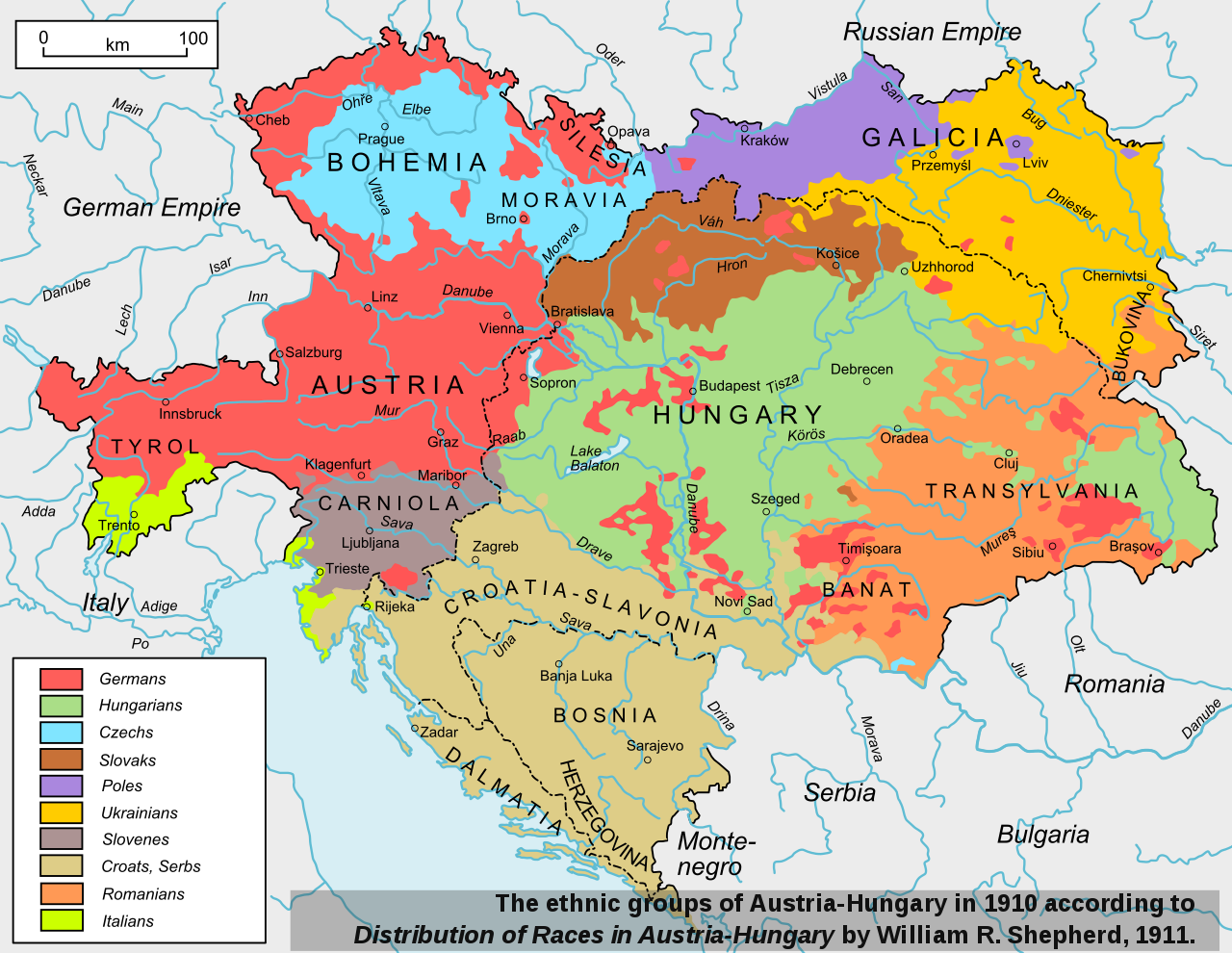
This was where the 2 new ideas of nationhood were starting to butt heads, territorial integrity, every nation-state having its own land and borders, was hard to realise when the populations of these splintered territories weren’t neatly packed into different corners, where there were multiple populations each new state wanted the land for themselves, inside their borders, everyone wanted a piece of the pie, how could all of these groups have self determination, when they each determined the land was theirs?
On the 1st of November 1918 the Ukrainians formed what they called the “West Ukrainian People’s Republic” to represent regions of the former Austro-Hungarian territory where Ukrainians could be found, these regions were Galicia, Bukovina and Carpathian Ruthenia.
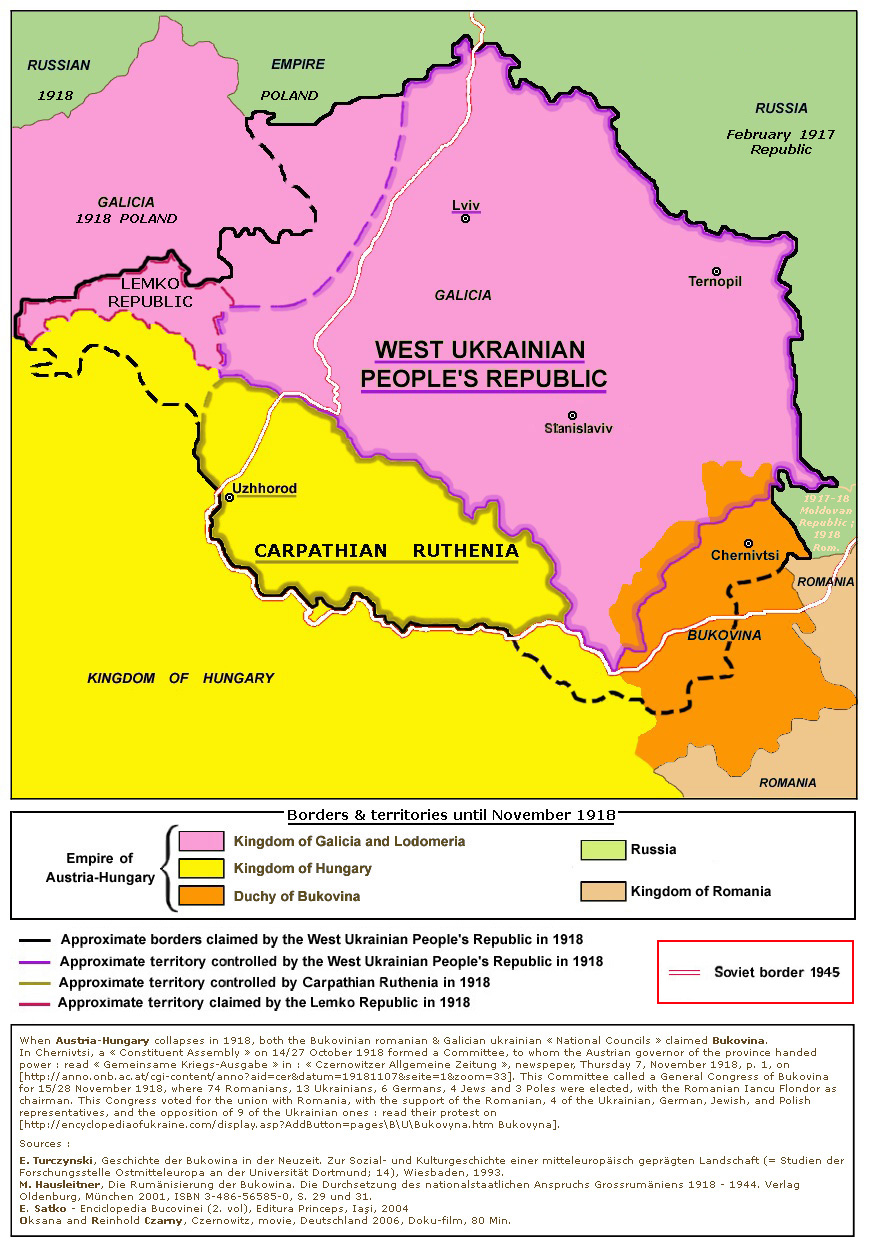
But there were other groups in these regions too, in Galicia around half of the population was Polish, in Bukovina a notable portion of the territory was Romanian and in Ruthenia a decent chunk was Slovakian.
The Polish formed their own state called the Polish Republic, the Romanians joined the neighbouring Kingdom of Romania, and the Slovaks united with the Czechs to form Czechoslovakia, leaving the Ukranians of West Ukraine facing 3 other countries that wanted the territory for themselves.
Bukovina was almost immediately lost to Romania but the other 2 territories, Galicia and Ruthenia, were fought over, suddenly Ukrainians were represented by 2 different states and both of them were under threat.
1.3: History - Ukraine in Wartime #
Only 10 days after this West Ukrainian Republic was formed, what was left of the Central Powers surrendered to the Allies, releasing the Soviet Russians from their obligations to stay out of the former Russian Empire and allowing them to reform the Soviet Republic of Ukraine, a month later the Ukrainian People’s Republic was also restored, as the German aligned “Ukrainian State” collapsed after a withdrawal by the Central Powers from Ukraine.
But the exit of the Central Powers didn’t make Ukraine any more peaceful, in fact things got even more chaotic, with the UPR and Soviet Ukraine both being reformed and ready to oppose each other, two more groups also emerged, both opposing all the other factions: A militant Ukrainian Anarchist group called the Makhnovists, which became known as the Black Army, and lesser known groups known as the Green Army. The country also still wasn’t free from foreign occupation, as the Allies increased their troop numbers in Ukraine after the German withdrawal as part of their so-called “Southern Russia Intervention”.
As Ukraine welcomed the new year of 1919, West Ukraine signed a treaty to unite with the UPR as one large Ukrainian nation and the Black and Red Armies agreed to cooperate with each other as the Reds moved to reoccupy Ukraine, this made everything worse, as it threatened to drag the elements of Russia’s Civil War into the remains of Austria-Hungary and its squabbling nationalist groups, forcing Ukrainians to deal with the infighting between countless different factions.
One scholar described the crisis like this:
Even more armies were involved than this describes, as the Ukrainians and West Ukrainians were one country but they had separate armies, the Entente had multiple foreign armies involved and the Poles weren’t the only nationalists involved in the conflict, various other nationalists were still fighting West Ukraine over Carpathian Ruthenia.
But eventually the conflict began to slowly die out as the factions whittled each other down:
-
The Ukrainian Green Army didn’t survive 1919 and neither did the Red/Black Alliance or the Allied occupation, the West Ukrainians also lost Ruthenia, which was later given to Czechoslovakia by a peace treaty called the Treaty of Trianon, a deal between the Allies, most of the nationalists of former Austria-Hungary and Hungary itself.
-
In 1920 the UPR fighters signed a deal of their own called the Treaty of Warsaw, agreeing with the Polish nationalists to give up Galicia and form an alliance against the Red Russians.
-
In 1921 after periods of cooperation and conflict between the Black and Red Armies, they turned on each other for the last time, with the Black Army being wiped out.
-
By 1922, the Soviets were mopping up what remained of the White Russians and had consolidated their power in both Russia and Ukraine, they decided to make a deal with the Poles and the other ex Russian territories of Finland and the Baltic States of Latvia, Lithuania and Estonia, leaving them to remain independent outside of Communist control in exchange for peace with the Soviets, this allowed the Poles to consolidate power over Galicia and left Ukrainians split between Soviet, Romanian, Czechoslovakian and Polish rule.
[Editor’s Note: There were also a few other proto-states for Ukrainians, most with a Ukrainian identity, but some with Russian or other identities, most of these proto-states were very small territories, usually comprising small collections of villages, and they usually didn’t last that long, all of them were dissolved by the time the civil wars had ended.
The full list of these statelets, with notes, can be found in the sources list.]
By this point the rest of the former Russian Empire had fallen under the control of the Communists and they dissolved the Ukrainian People’s Republic. The Communist held territory was brought together as the Union of Soviet Socialist Republics in 1922 with Ukraine becoming a founding member known as the Ukrainian Soviet Socialist Republic, a territory that wasn’t just an autonomous part of Russia, but a Republic in its own right.
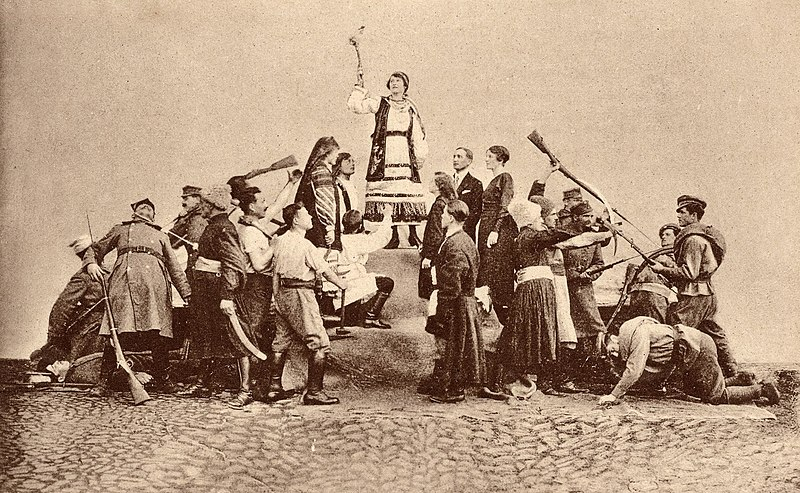
You were likely taught in school that World War One was from 1914-1918, but here we can see a different perspective. It was more like 1914-1922, when the border wars finally stopped and all the changes were finally sorted out, double the length we know it as.
So why is it only thought of as a 4 year war rather than an 8 year one? Well, for the second half a bunch of the major parties from the first were dead or not participating, that’s done some damage to the textbooks.
In 1923, after all this fighting was over, the final border changes looked like this:
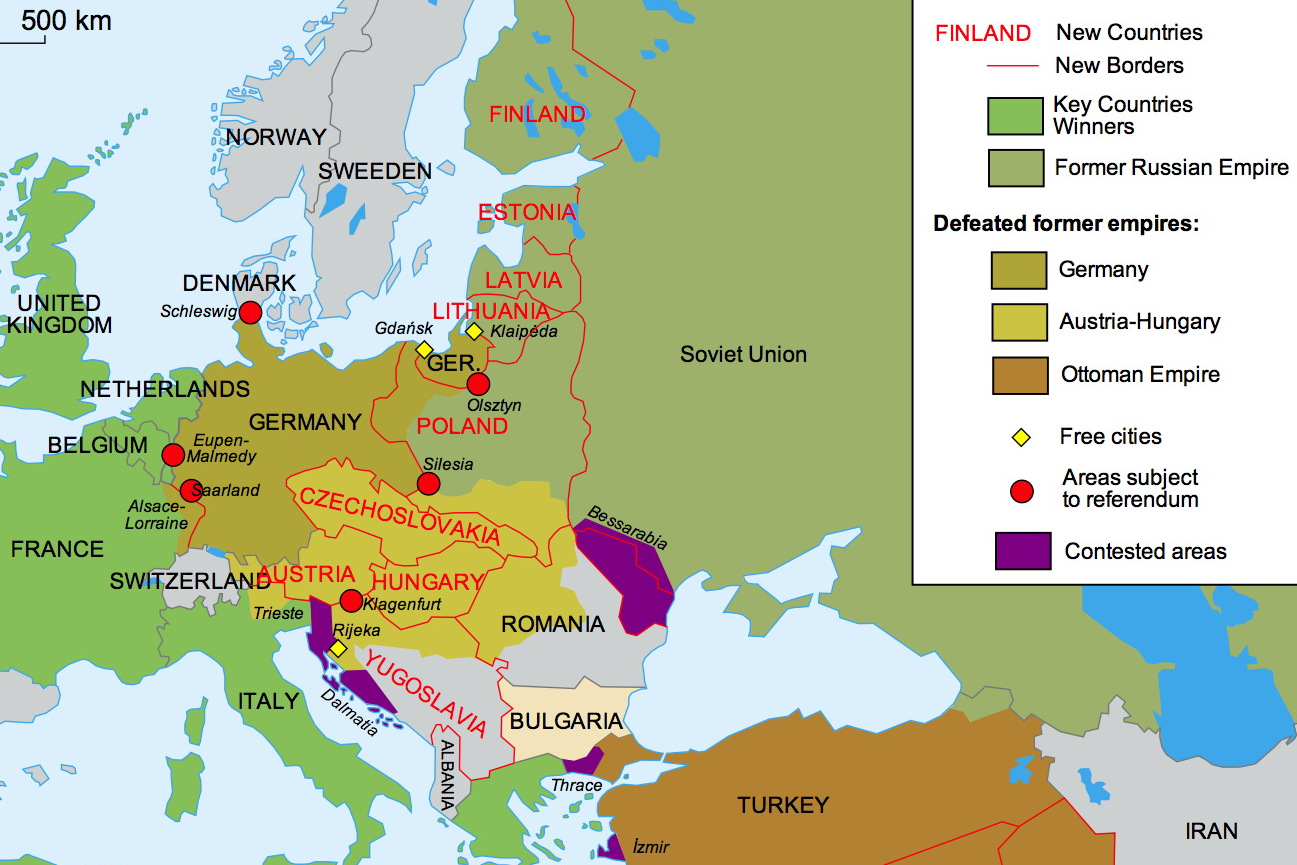
The result of a conflict where both sides lost, the Allies in the Eastern Front, the Central Powers in the Western Front, 9 new countries were created in this time and Ukraine wasn’t one of them.
The Ukrainian independence movement had failed to follow the model of the other nationalist groups from the former Russian and Austro-Hungarian Empires and secure Ukraine’s place as an independent country, being brutally splintered between various powers instead, self determination had been achieved for some, but not all.
But the Ukrainians could claim some success, recognition as a people, they ensured that Ukraine was recognised as a place of its own rather than as just another province of a foreign power, these people weren’t Russians, Poles or Austrians, they were Ukrainians, the Ukrainian people were their own, born in the fires of war.
1.4: History - Zweiter Weltkrieg #
A decade later, in the late 1930s, Germany had recovered from the humiliation of defeat and came under the leadership of Fascist dictator Adolf Hitler, who formed alliances and rearmed his country. Germany’s resurgence caused Europe to split once again into two factions, one led by France and the UK, the other led by Germany, the Allies and Axis.

Hitler made his first military moves in 1938 when he began invading former Austro-Hungarian territories: First he annexed Austria itself and then he claimed Czechoslovakia, which you might remember as one of the countries that had taken a piece of Ukraine in the aftermath of the First World War; The Ukrainians in the Czechoslovak region of Carpathian Ruthenia tried to take advantage of this and declared their own independent state called the Republic of Carpatho-Ukraine.
But the Germans ignored them and almost immediately after, with the blessing of Germany, they were invaded by Hungary, placing the Ruthenian Ukrainians back under foreign rule.
After it became clear that the peace settlements of the 1920s weren’t going to hold, the Soviets worked to ensure their own security. After failing to reach a deal with the Allies the Soviets signed an agreement with the Germans and agreed to divide Eastern Europe with them, together they invaded Poland in 1939, with most of Galicia being absorbed into Soviet Ukraine and the rest of Poland being divided between Germany, its partners, and other Soviet Republics.
The Allies reacted strongly to this and demanded that the Germans, but not the Soviets, withdraw from Poland under the threat of war, when Germany refused the Allied nations followed through on their threat, beginning the Second World War. As the war began, the Soviets also took over the Ukrainian sections of Bukovina, the only Ukrainian region left to recover was Ruthenia.
The cooperation between the Soviets and the Germans was short lived, as Hitler was extremely Anti Communist and didn’t want to just take the remains of Austria-Hungary’s dead empire, he wanted the leftovers of the Russian Empire too as “living space”; Germany invaded the USSR in 1941 with Ukraine being one of the first Soviet Republics to be invaded, the Germans occupied Ukrainian territory and split it between two entities, the District of Galicia and Reichskommissariat Ukraine, neither of which were recognised as independent, many Ukrainians fled to join the Soviet Red Army or local partisan groups.
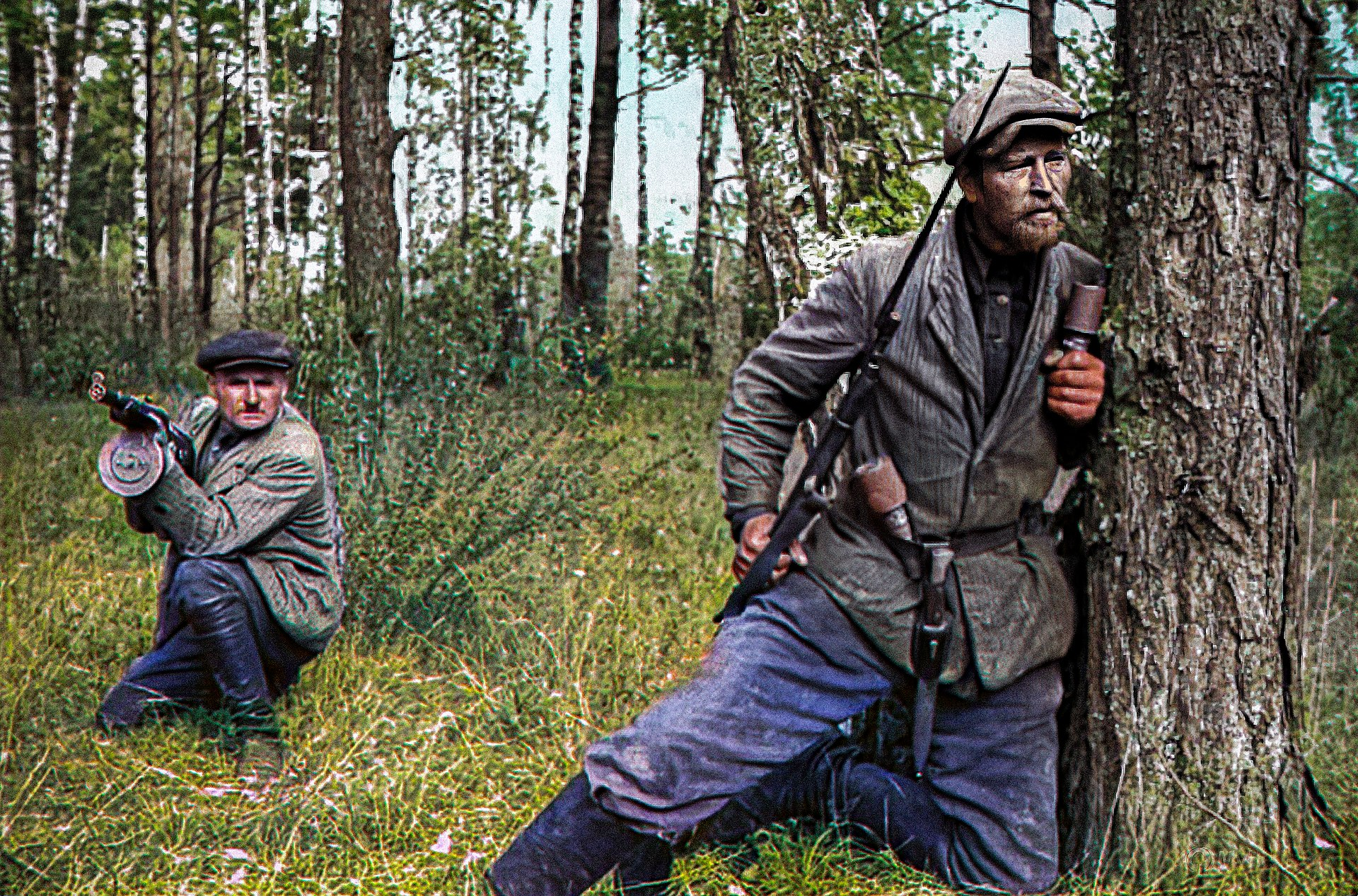
Under German occupation, a group known as the OUN or “Organisation of Ukrainian Nationalists”, which had been operating underground in areas like Galicia before the invasions of Poland and the USSR, began to take over large parts of Ukraine.
The OUN was split between two factions, the OUN-M led by a man called Andriy Melnyk, and the OUN-B led by a man called Stepan Bandera, both factions raced to entrench their control over Ukrainian territory and gain support, from both the local population and the German forces.
8 days after the Nazi occupation began, the OUN-B issued a declaration of Ukrainian independence called the “Act of restoration of the Ukrainian state”, this declaration proclaimed that a government was being formed in West Ukraine, and that it would be subordinate to a central Ukrainian government in the capital of Kyiv, it also declared that the new Ukrainian state would “work closely with the National-Socialist Greater Germany, under the leadership of its leader Adolf Hitler which is forming a new order in Europe and the world and is helping the Ukrainian People to free itself from Moscovite occupation”.
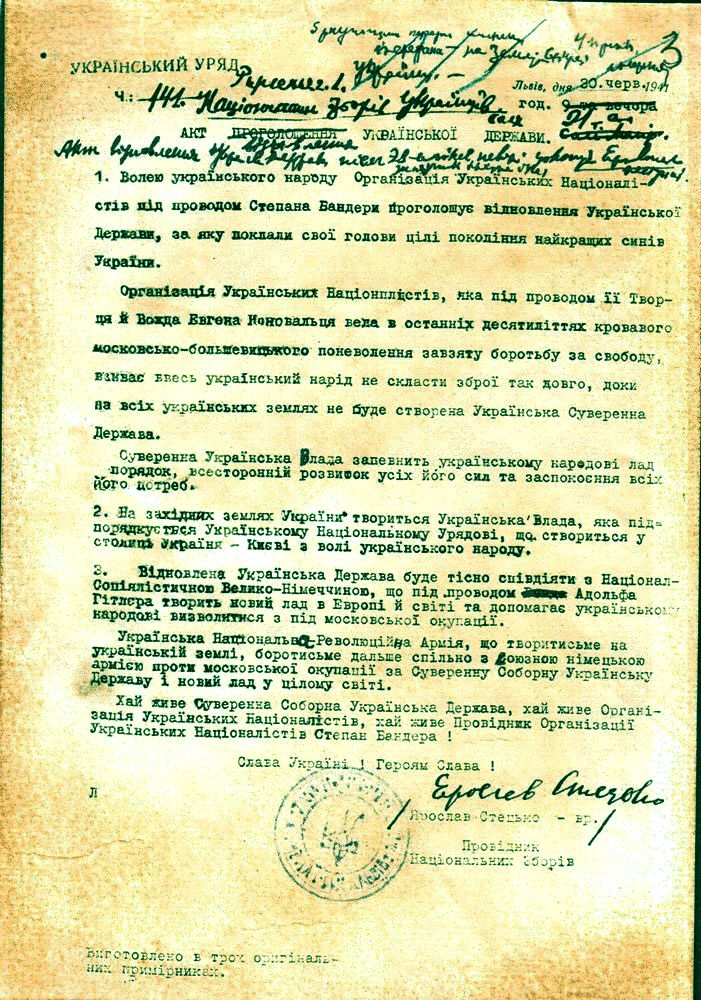
Bandera and his front hoped that by declaring their loyalty to Germany the Nazis would allow them to form their independent Ukrainian state, instead the Nazis arrested the OUN’s leadership and threw them into concentration camps, with both OUN factions purged.
The remnants of the groups formed 2 different armies, the OUN-B led Ukrainian Insurgent Army and OUN-M led Ukrainian People’s Revolutionary Army, the Nazis also formed their own forces: A Ukrainian volunteer SS group, the Galicia Division, and other proxies such as the Ukrainian Auxiliary Police.
By 1944 the tide of the war had firmly turned in the favour of the Allies and the Soviets were steadily advancing through German occupied Europe, the Nazis released Bandera and other OUN leaders from prison in the hopes that the two OUN factions could unite and attack Soviet troops, damaging their advance.
They reorganised the Galicia Division into the so-called Ukrainian National Army, under the leadership of a German sponsored “Ukrainian National Committee” linked to both OUN factions, which the Axis finally recognised as representatives of an independent Ukraine.
[Editor’s Note: Reportedly some other collaborator units also participated in the UNA alongside the Galicia Division, one unit the Encyclopedia of Ukraine mentions is an unnamed Anti-Tank Brigade commanded by a “Col P. Diachenko”, Wikipedia names him as Petro Dyachenko and his unit as the “Free Ukraine” Brigade.]
But the German efforts didn’t bear fruit, by late 1944 Reichskommissariat Ukraine had already crumbled, with the remaining collaborators fleeing, fighting for the Nazis elsewhere in Europe or carrying out a small insurgency behind Soviet lines. 2 months after the recognition of the German backed Committee the Nazis unconditionally surrendered to the Allies, including the Soviet Union, the war was finally over but several million Ukrainians had died in the fighting, while Ukraine had still failed to achieve independence the Ukrainians kept the territory that had been annexed by the USSR after the invasion of Poland.
The Soviets had also taken over Carpathian Ruthenia in the last stages of the war, and annexed its Ukrainian portions into the USSR, finally uniting the Ukrainian people under one republic, even if it wasn’t an independent one. Soviet Ukraine was restored and the OUN returned to the underground.
As the Cold War set in and the relations between the USSR and USA turned from alliance to rivalry, the CIA courted the OUN, seeking to use OUN-linked expats in Germany and the underground inside Ukraine itself for intelligence gathering and psychological warfare against the Soviets and their Communist allies in Poland, Czechoslovakia and Romania, to this end the OUN attempted to whitewash their past collaboration attempts with the Nazis, and emphasise their later opposition to the Nazis that took place after these efforts failed, they hoped to earn support in the West by appearing to be both Anti-Nazi and Anti-Soviet.
Bandera was one of these expats, and remained in Germany to lead the OUN with the aid of US intelligence services, who helped him avoid discovery by the Soviets, ultimately these efforts failed, as Bandera was later assassinated and the OUN insurgency was wiped out by the Soviet security forces, with remaining sympathisers either fleeing to join the expat community or hiding their views well for the rest of the Soviet era.
[Editor’s Note: The OUN’s involvement in the Ukrainian National Committee is also a highly contested topic, some have claimed that Bandera and the OUN refused to collaborate with the Nazis after their release from the camps, and sources indicate that Bandera told both the CIA and OUN members that he hadn’t participated in the committee. (See: The Ukrainian Central Committee, 1940-1945: a case of collaboration in Nazi-occupied Poland, Page 533)
But Pavlo Shandruk, the head of the Committee, clearly mentions Bandera as offering his “full support to the end” and having “good will and respect” towards the committee in his book “Arms of Valor”.
So it seems that Bandera lied to the CIA and even his own people about his collaboration with the Nazis near the end of the war, most likely to present the image that the OUN only briefly worked with the Nazis and then quickly broke relations for good after its leadership was arrested. This is an impression that many apologists for the OUN continue with to this day, but Shandruk’s account shows that Bandera was still willing to collaborate with the Nazis even at the very end of the war, as long as his condition: Recognising Ukrainian nationhood, was met.
Also, in addition to the CIA aiding the OUN the British government also helped veterans of the SS Galicia Division resettle in the UK and Canada, where they joined the Ukrainian expat community.
- For more info on this topic you can watch the video “Ukrainian SS In Britain - Postwar SS-Galizien Division Refugees” by Mark Felton https://www.youtube.com/watch?v=UB_Gs-0dhOo
1.5: History - Goodbye USSR #
Fast forward to the end of that era, in the early 1990s, and thanks to a combination of botched reforms, economic stagnation and growing war costs the USSR was crumbling just as the Russian Empire and Republic had previously, in March 1991 a referendum was held on preserving the USSR by its leader, Mikhail Gorbachev, and most of the Soviet Union’s member states, Ukraine included, voted to stay in the union in exchange for more sovereignty for their republics.
But in August 1991 a military coup was launched against Gorbachev led by Soviet hardliners unhappy with his reforms, the coup failed and Gorbachev returned to power with his credibility as a leader tainted. Later in the month Ukraine voted on independence and the Ukrainian people, seeing pending demise of the union, voted overwhelmingly to leave the USSR.
In December 1991 the leaders of Russia, Ukraine and Belarus decided to declare an end to the USSR and with its 3 biggest member states gone the largest country on the planet fell like a jenga tower.
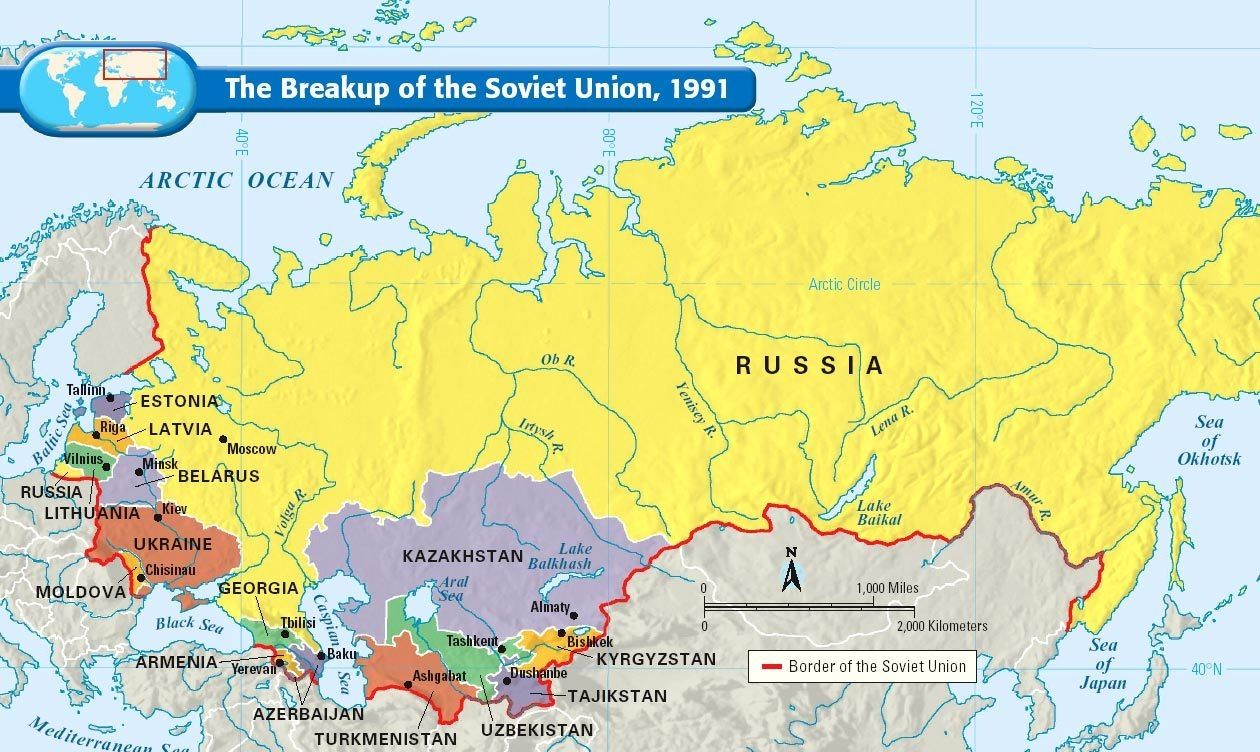
15 new countries were created and Ukraine was one of them.
For the first time in several hundred years Ukraine was its own country completely separate from foreign rule, the fight for Ukrainian independence was finally complete.
But there was a problem with this process: The Soviet Republics which these new countries were inheriting everything from weren’t designed to become the markers for international borders.
The Republics were essentially recognitions of different identities and languages within the wider Soviet community and they swapped lands, gained and lost autonomy and status arbitrarily over time, at the whim of politicians who never imagined they would one day become separate countries, often without the consultation of the local people.
Karelia is an example of this, a place you’ve probably never heard of, it used to be its own Republic called the Karelo-Finnish (Soviet Socialist) Republic when it first became part of the USSR, but it was downgraded to an autonomous part of Russia in the 1950s, in the same decade the Oblast of Crimea, which you probably have heard of, was transferred from Russia, its original Republic, to Ukraine; If decisions like these were never made our history could have looked very different now.
On top of this, the Soviet authorities had contradictory attitudes towards non-Russian populations through the USSRs history, initially promoting a policy known as “indigenization”, where local languages and identities were emphasised and encouraged, then later reversing the policy and either neglecting these identities or promoting Russification instead, this process was not helped by the fact that before and during WW2, millions of people throughout the Soviet Republics were shuffled around into different territories, under a system now known as “population transfer”, leaving masses of people outside of their ancestral homelands and a jumbled mess of populations with an inconsistent level of attachment to their national identities.
Decision makers could get away with this at the time because the places they were marking out were all still part of one big country and one big grouping, the Soviet people and the Soviet Union, their sudden leap from regions to whole new countries was chaotic and resulted in territorial disputes, inflaming ethnic tensions almost overnight and even leading to major wars, this instability almost spread to Ukraine through Crimea.
Shortly before the end of the Soviet Union Crimea changed from an Oblast to an Autonomous Soviet Republic, the status it had previously when it was part of Soviet Russia, in 1992 after independence Crimea got a new constitution and was renamed to the “Republic of Crimea”, in 1994 a politician named Yuri Meshkov was elected to the Crimean Presidency, aiming to pivot the region away from Ukraine and towards Russia, proposing moves like granting Crimeans Russian citizenship and moving Crimea’s time zone to be in line with Russia’s, but his dream didn’t last long, in 1995 he was arrested by the Ukrainian military, put on a plane and deported to Moscow, and a new constitution was formed, the “Republic of Crimea” became the “Autonomous Republic of Crimea”, with closer political ties to Ukraine, this killed off the idea of Ukraine joining any kind of “Russian World”, for the time being at least.
But the differences in identity that caused those ideas to emerge in the first place still existed, because Ukrainians and all the other Post-Soviet people’s were still trying to find their footing, to understand what nations they belonged to and what it meant to be part of these nations, this was a struggle because they just didn’t have a lot of practice, for the past century their taste of nation building had been extremely brief; as they were beginning to find their way from the aftermath of the Russian Empire and other dying kingdoms, they were all swallowed back up into one country again and meshed into one experimental, often confusing identity, the Soviet identity. With that identity gone, these people all had to figure out what to do with themselves, and with a legacy of contradictory identity politics that’s easier said than done.
[Editor’s Note: Alongside the Crimean Pro-Russians, there was also a Pro-Russian organisation in Eastern Ukraine from 1990-2003 called the “International Movement of Donbas”, the organisation opposed the breakup of the USSR and later the “Ukrainianisation” of Donbas, but didn’t lead to any serious attempts to split up parts of Ukraine or unite them with Russia
Some have considered the Donetsk Republic party, the ruling party in the Donetsk People’s Republic, as the successor of this movement, the DPR uses a similar flag to the movement’s]
To illustrate just how problematic this became for Ukrainians, here are some quotes from an article by The Washington Post:
Ukraine’s politics have long been divided into two major factions by the country’s demographics. […] roughly speaking, about four out of every six people in Ukraine are ethnic Ukrainian and speak the Ukrainian language. Another one in six is ethnic Russian and speaks Russian. The last one-in-six is ethnic Ukrainian but speaks Russian.
Of course the article’s description is a generalisation, not every Russian speaker wanted closeness with Russia, or every Ukrainian speaker closeness with Western Europe, but Ukraine’s ethnic and political divisions were clearly strong elements of society, this is the kind of crisis that Ukraine found itself trapped in, once again the contradictions between self determination and territorial integrity were rearing their ugly heads.
Essentially, as Ukraine got closer and closer to becoming its own country, thanks to the largest nation on earth dissolving twice, first as the Russian Empire, second as the Soviet Union, the differences between sects of its society became harder to ignore. These gaps were widened with the resurgence of the far right to Ukraine, with Ukrainian expats from Germany returning home to reform the OUN as the “Congress of Ukrainian Nationalists” or “KUN” for short, local Ukrainians soon followed suit and shortly after independence there were several different far right blocs emerging, earning a degree of sympathy and plenty of hate.
1.6: Maidan - Pro vs Anti #
Fast forward to 2010 and Ukraine has elected its 4th president, Viktor Yanukovych. Yanukovych was a politician that viewed Ukraine as a neutral power, one which should remain close to both the West and Russia and shouldn’t join either’s military alliances, in an attempt to balance the country’s fragile sects, he also aimed to bring Russian speakers together with Ukrainian speakers by recognising Russian as a second official language alongside Ukrainian, passing a law to make minority languages official after 2 years in office.
But Yanukovych was in a shaky position from the start, having narrowly been elected on only a 3% lead over his rival Yulia Tymoshenko, with the West of the country overwhelmingly rejecting him and the East overwhelmingly supporting him.

And where Ukraine’s divide truly tore Yanukovych apart was the issue of membership of the European Union, where there wasn’t much room for neutrality: EU membership was a policy with strong support in Ukraine’s West but much weaker support in its East, one camp wanted it and the other camp didn’t, damned if you do, damned if you don’t.
Throughout his presidency Yanukovych had pledged to support membership with the EU, but in late 2013, following pressure from Russia to back away Yanukovych refused to sign an Association Agreement that would’ve brought Ukraine one step closer to EU membership, and his party rejected a number of reforms that the EU demanded as a condition for joining, essentially sabotaging their own application process.
This sparked outrage among Pro Western elements of Ukrainian society and led to the formation of the Euromaidan, a protest movement that demanded a return to plans for EU membership and the resignation of Yanukovych and his government, Pro Russian elements of Ukraine responded with a counter movement, the Anti Maidan, in opposition to the protests, large opposing forces born from Ukraine’s long running political divisions.
To quote from The Washington Post again:
The mass protests, and thus most foreign journalists, are in the capital city of Kiev. […] But President Yanukovych is from the eastern, more Russian part of the country, where he served as a regional governor for several years. In 2010, 74.7 percent of Kievans voted for Yanukovych’s opponent; it’s not shocking that they would want him to leave office.
1.7: Maidan - The 5th Column #
But the conflict wasn’t as simple as Pro EU Maidan and Pro Russia Anti Maidan, within the Maidan there was another element as well, the far right, who sought to exploit the unrest for their own agenda and give their idolisation of WW2 era Nazi collaborators like Stepan Bandera and the SS Galicia Division a more mainstream platform, they had almost nothing in common with the rest of the Maidan, which consisted mostly of liberals, progressives and moderates, but the 2 sides shared an opposition to Yanukovych and to Russian influence. The most notable of these far right groups were the Svoboda Party, which emerged in the early 2000s, and the Right Sector, a coalition of various far right groups, including elements of the KUN, which emerged during the Maidan itself.
[Editor’s Note: The KUN element mentioned here is the “Trident” organisation]
These groups united with several Pro EU liberal parties in a formal organisation called “All-Ukrainian Union Maidan”, which formed paramilitary groups known as the “Maidan Self Defence Groups” to lead the fight against the Anti Maidan and government forces, the far right and liberal groups of the Maidan quietly tolerated each other to oppose these mutual enemies, even as the far right set out to hijack the Maidan’s agenda and replace it with their own.
And hijack they did, these groups were not widely supported by Ukrainians either in the east or the west, but they were militant, prominent, and willing to go all out to oppose both Yanukovytch and Russian influence, and fighters loyal to groups like Right Sector led the charge at the helm of the “Self-Defence Groups”.
The visibility of far right groups like Right Sector during the Maidan protests increased the hostility of the Anti Maidan in response, as they began to see the modern Ukrainian conflict between them and the Maidan as a kind of parallel with the conflict between Soviet Ukraine and insurgent groups like Bandera’s OUN of the 1940s, suddenly the Anti Maidan had a new name for the Maidan supporters, “Banderite”, Ukraine’s World War Two legacy came back to haunt its people.
After Yanukovych refused to compromise with the Euromaidan, with his government insisting there would be no return to negotiations with the EU, the crisis progressively got worse; The protests spiralled out of control and spread across Ukraine, leading to violent confrontations between the two protest camps and the police across the country.
These confrontations escalated into riots and then, at the start of 2014, into a full scale uprising, like a pin being pulled out of a grenade.
Waves of Maidan protesters began occupying government buildings across Ukraine and by late January 2014 almost half of Ukraine’s regional governments had been ousted and replaced by the rioters, these activists then declared the regions under their control to be “independent” from the central government, in some instances even “banning” the ruling party and its allies.
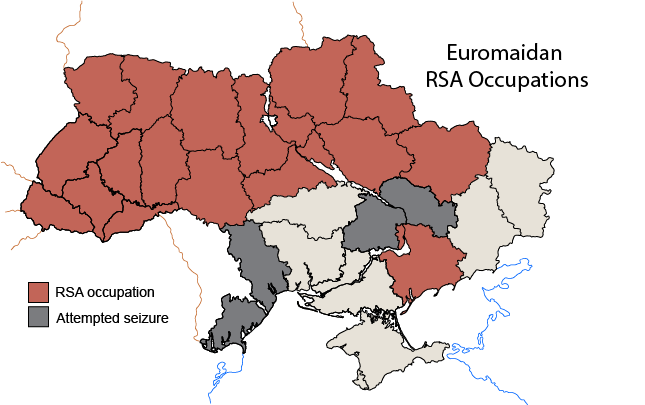
With the West of Ukraine coming under the control of the separatists and the East remaining with the government, there was a genuine fear from some observers that Ukraine could be split into 2 states, one controlled by the opposition and the Maidan and the other controlled by the government and the Anti-Maidan.
In a last ditch attempt to prevent this kind of outcome, opposition leaders made a deal with the government on the 21st of February, where early elections would be held and more power would be transferred from the presidency to the Ukrainian parliament, but Right Sector and other opposition militants from the so-called “Maidan Self-Defence Groups” rejected the deal, threatening to storm Yanukovych’s house and the Ukrainian parliament building if the government didn’t resign, the next day Yanukovytch fled Kyiv and the militants took control of parliament and other government offices, during the occupation opposition members of parliament impeached Yanukovytch, appointed a new leadership headed by the opposition, known as the “interim government”, ousted top judges, and replaced the country’s regional governors, the far right movements benefitted from this new leadership, with groups like Svoboda receiving official posts in the new government.
The impeachment process that brought this new government to power was unconstitutional, as rather than following the constitution’s legal impeachment proceedings, which involve a trial for a specific crime, a 2 thirds majority vote from the parliament to accept the claims from the trial, a vote from the supreme court to validate the decisions, and finally a 3 quarters vote for conviction, the opposition MPs instead passed a basic resolution declaring Yanukovytch was absent from his post due to his flight from Kyiv, something which wasn’t a crime or an impeachable offence, the opposition also failed to achieve the 2 thirds majority due to an absence of most MPs from the ruling party during the vote, as a result of these irregularities Yanukovytch rejected the impeachment and maintained his claim to the Presidency, resulting in a constitutional crisis.
In terms of public support, in the east of Ukraine, an Anti Maidan stronghold, the local population was much more split on the Maidan than the rest of the country, where most had been willing to look past the murkiness involved in Yanukovych’s removal due to either a shared Pro Western sentiment with the new government, or a resentment for the violent role Ukrainian government forces played in the Maidan clashes under his watch.
Poll results indicated that in the West of the country most believed that the Maidan had been a kind of “revolution” against a “dictator", while the East saw it as a coup against an elected leader, and didn’t recognise the opposition’s takeover, much of the population had also begun to believe a civil war was possible or certain.
After leaving Kyiv for the Kharkiv region Yanukovytch later moved to exile in Russia, but he still refused to resign, he later gave a press conference denouncing the events as a coup and claiming he was shot at while leaving the capital, shortly after he requested that Russian troops intervene to restore order.
1.8: Maidan - Ukraine’s Third War #
Following this request Russian troops crossed the Ukrainian border and entered the peninsula of Crimea, but not to restore law and order and Yanukovytch’s position as the President of Ukraine, but rather to claim Ukrainian territory for themselves, surrounding and taking over Military bases and crimean government buildings with support from Pro-Russian activists. At first the Russians played dumb, explaining these events with the baffling excuse that these troops weren’t Russian soldiers at all, but rather spontaneously formed “Self-Defence Groups’’ made up of local Crimeans, the fact that their uniforms happened to be identical to that of Russian soldiers, only with the unit patches ripped off, was conveniently explained away as the “Self-Defence Groups” having equipped themselves from “army surplus shops”, later the Russians dropped the act and admitted that the soldiers who looked and were equipped exactly like Russian troops were, in fact, Russian troops, funny that.
A month after Russian forces deployed to Crimea the Crimean Parliament, under Russian occupation, issued a declaration of independence proclaiming Crimea to be independent from Ukraine, shortly after a referendum was held in Crimea on joining Russia, with an official result of over 95% in favour, over 80% turnout, but there were a few obvious problems with this referendum:
Firstly, there was no option to preserve the status quo, the only choices were joining Russia or returning to the 1992 Crimean constitution, in other words move further away from Ukraine or leave it entirely.
Second, status referendums in Ukraine have to be called by the Ukrainian Presidency or Parliament and be open to participation from the whole Ukrainian electorate, not just the territory which would change status, the Crimean referendum was organised by Crimeans acting under duress, and neither President Yanukovytch, the “Interim” President Oleksandr Turchynov, or the Ukrainian parliament approved the referendum.
Third, the status referendums have to be “All-Ukrainian Referendums” where citizens from across the country can take part, the Crimean referendum only allowed local Crimeans to take part, these factors made the referendum illegal under Ukrainian law.
Legal issues aside, what matters most is whether the referendum represented the will of the people, when judging this the first factor is impossible to look past, a “yes” or “no” referendum without a genuine “no” option can hardly claim to be a genuine consultation.
But regardless of these issues, which prevented the referendum from being recognised internationally, the territory was promptly annexed into the Russian Federation, leaving Yanukovytch bitter and regretful for allowing Russian troops into Ukraine, shortly after he faded from the political scene and his claim to Ukraine’s presidency was mostly forgotten, the crisis was no longer between his government and the “interim” government, but between the “interim” government and Russia.
Emboldened by the takeover of Crimea, the Anti Maidan movement in mainland Ukraine turned to using the same tactics the Maidan had: Rioting and occupying government buildings.
The Eastern regions of Kharkiv, Donetsk and Luhansk came under occupation from the Anti-Maidan, and with the changeover of power from Yanukovytch to the new government the political situation had taken a 180 degree turn, the Anti-Maidan were now the separatists.
Unable to advance westward due to the strength of the Maidan there, these forces later declared the areas they controlled, portions of the eastern regions of Donetsk and Luhansk, to be 3 new countries, the Kharkiv People’s Republic, Donetsk People’s Republic and Luhansk People’s Republic, independent from Ukraine, the activists in Kharkiv were pushed back shortly after and the region remained under Ukrainian control, but Donetsk and Luhansk became split between Pro-Separatist and Pro-Ukrainian forces.
To prevent the Western authorities from further retaking territory, some of the Anti-Maidan activists formed their own vigilante paramilitaries, like the Maidan’s groups there was a distinct ideological split in these paramilitaries, some of them were associated with the Far Left, some with the Far Right, and they were also split in origin, some groups were local, others were connected to political groups inside Russia itself, such as the Russian National Unity, which had figures that had passed through its ranks leading the charge for the separatists, and the Russian Imperial Movement which organised training for separatist forces.
Following their declarations of independence, the separatists in Donetsk and Luhansk held referendums in their regions to validate the decisions, similar to the Crimea referendum. And like the Crimea referendum, the referendums in Donbas proved to be extremely divisive, and were viewed internationally more as power plays than real expressions of opinion, no country gave them recognition, not even Russia. The result was a crisis of legitimacy and a land split between 2 rival centres of power, a government and a separatist bloc that had both taken power by illegal means.
The Ukrainian security forces were utterly shattered by the takeover of Crimea and the uprising in Donbas, as most them weren’t combat ready and many of those who were chose to defect to the separatists:
According to a US scholar, the total number of usable troops and equipment in the ground forces amounted nominally to 80,000 personnel, 775 tanks, 51 helicopters, fewer than 1,000 artillery pieces and 2,280 armoured personnel carriers. In fact, due to a combination of lack of training and inadequate and poorly maintained equipment, the size of the combat-ready force was only 6,000 troops. Ministry of Interior (MoI) special forces, like the Berkut, were dissolved after the shootings in Maidan. Between 25 and 30 percent of police and security forces in the Donbas region had defected to the separatist side, according to a MoI estimate.
As a result, the Pro Ukraine side came to be led not by its army or its police forces, but by paramilitaries known as the “volunteer battalions”, many of which were successors of “Self Defence Battalions” that had refused to disarm after the overthrow of Yanukovytch, the Right Sector formed a group called the Ukrainian Volunteer Corps, Svoboda formed a unit known as the “Sich Battalion”, one of the constituent groups of Right Sector, Patriot of Ukraine, formed a militia known as the Black Corps, the growth of this militia movement increased the perception among Eastern Ukrainians that the country had been captured by the “Banderites”, while the emergence of Russian citizens in the Pro Russian forces led those in the Westerners to believe they were fighting a kind of hybrid war with Russia itself, the vigilantes controlling the streets became the soldiers controlling the front lines.
To resolve the ongoing constitutional crisis Presidential elections were held in Ukraine by the so-called “interim government” in May 2014, followed by parliamentary elections in October, which resulted in a win for Pro-EU liberal leader Petro Poroshenko and his political group, the Petro Poroshenko bloc, which formed a new government that was recognised internationally, including by Russia.
The far right badly lost out, with Svoboda losing 31 seats and the Right Sector gaining only 1, their only seat in the parliament, this led to them losing their places in Ukraine’s leadership, but by this point it was too late for a smooth resolution to the crisis and the far right still held a disproportionate amount of influence through their sway over many of the volunteer battalions, these battalions were then given legal power and status by being formally incorporated into the Ukrainian government under newly created units of the Ukrainian military and police, the “National Guard”, “Territorial Defence Battalions”, and “Special Tasks Patrol Police”.
Following the elections Pro Russia separatists refused to recognise the new government’s mandate and had established control over large parts of the Donbas region (made up of Donetsk and Luhansk) for their republics, they too formalised the vigilantes that had backed their side, organising them into what was called the Donetsk and Luhansk “People’s Militias”, the separatists’ national armies.
These two sides were in a state of war as they each tried to take over the Donbas region, after it was discovered that the Russian government was giving military aid to the separatists the conflict commonly became grouped together with Russia’s annexation of Crimea under one name, the Russo-Ukrainian War.
The war continued for 3 months until September 2014, when the Russian, Ukrainian and Separatist leaders signed an agreement called the Minsk Protocol, where it was agreed that there would be a ceasefire, followed by a political solution: Separatist regions would be given autonomy and separatist fighters would be given immunity from prosecution, in exchange the separatists would agree to reintegrate into Ukraine.
But the agreement fell through as the ceasefire was periodically broken, with combat continuing across Donbas, the political process was also stalled as the separatists showed no genuine interest in any reintegration with Ukraine and Ukrainian politicians were unwilling to support the proposed amnesty for the separatists, following this lack of progress the separatists ended up holding their own elections in November 2014, with wins for the Russian nationalist “Donetsk Republic” and “Peace for Luhansk” parties, creating a parallel set of parliaments, one in Kyiv and 2 more in Donbas.
In February 2015 an attempt to revive the diplomatic process was made and a new agreement known as Minsk 2 was signed, based on the same idea of a ceasefire, autonomy in exchange for reintegration, but once again it failed to be seriously implemented, immediately after the deal was settled the separatists vowed not to follow the ceasefire in a major area of fighting, the city of Debaltseve, and some Ukrainian volunteer units openly refused to follow the ceasefire at all, the result was a complete failure to achieve any political progress and a stalemate on the battlefield, the Donetsk and Luhansk Republics remained separated from Ukraine, in control of about a third of the Donbas region.
The Ukrainians were determined to lick their wounds and recover from these losses, and to help achieve that end the Ukrainian government invited NATO troops into the country to train its army as it attempted to rebuild its conventional forces, the work Yanukovych had put into compromising with Ukraine’s two split camps progressively went out the window over time, his moves towards neutrality were ditched as the country made a Pro-Western, Pro-NATO pivot, now firmly aligned against Russia and wary of further Russian encroachment.
In 2019 Ukraine’s next round of Presidential elections saw the end of Petro Poroshenko’s term in power, bringing in new President Volodymyr Zelensky, who brought new hope for Ukraine, he was Pro European, but a Russian speaker, a campaigner against corruption and a far cry from the far right, having Jewish lineage, with family members that fought for the Red Army and fell victim to the Holocaust, he had the potential to be the unifier his predecessors weren’t, and had an ambition to resolve the Donbas conflict through diplomacy with Russia rather than force.
But one thing he was not willing to compromise on was guaranteeing Ukraine’s security against further Russian land grabbing, and for him that meant seeking membership in the NATO alliance, a red line for Russia, the tug of war between Russia and Ukraine over this issue continued until 2022, when Russia directly demanded that Western nations agree to keep Ukraine out of NATO, and invaded Ukraine when they refused.
And here we have reached the point where the war we know of began, and our first Ukraine documentary began its coverage. We can see that Ukraine is a very complicated country, compared to most European nations it’s very young, but it has also seen a great amount of history:
From the very beginning in 1918 and 1919 Ukraine was split between dozens of different factions with different ideas of how it should be run and how close it should be with neighbours like Russia, struggling countless times for independence against multiple Empires and rival nationalists, during the Second World War these issues resurfaced as Ukraine was fought over by the Soviets and Germans, and now it seems this new war is bringing these divisions to the surface all over again.
Ukraine watched as the biggest nation on Earth collapsed, and then they watched it happen again in the same century, each time it came out of that experience looking very different, the question now is, what will Ukraine look like after watching what happens to Russia this time around?
Chapter 1 Summary #
-
In the early 1900s, Ukrainians didn’t have their own country, the Ukrainian people were split between 2 Empires, the Russian Empire and the Austro-Hungarian Empire
-
These 2 empires participated in the First World War, also known as the Great War, which lasted from 1914 to 1918, they were both defeated
-
As the war ended the 2 empires collapsed, and their former territories were marked by conflicts between various nationalist groups, including Ukrainians
-
In the former Russian Empire, Ukrainians formed the Ukrainian People’s Republic, while in former Austria-Hungary, Ukrainians formed the West Ukrainian People’s Republic
-
These 2 Republics faced various threats, including rival nationalist groups and the warring factions of the Russian Civil War
-
Eventually, West Ukraine was occupied by rival nationalists from Poland, Romania and Czechoslovakia, while the UPR was defeated by the Communist Red Army
-
The Communists recognised Ukraine as an independent entity from Russia, but not as an independent country entirely, Russia, Ukraine and various other Communist controlled territories were brought together as the Union of Soviet Socialist Republics in 1922
-
The USSR later annexed Ukrainian territory lost to the rival nationalists in the 1930s, shortly after, World War 2 broke out
-
During the war, Ukraine was occupied by Germany, a group of Ukrainian nationalists led by Stepan Bandera attempted to create an independent Ukrainian state aligned to Germany, the Germans rejected this and Bandera was arrested
-
As the war was coming to an end, with a German defeat, the Germans released Bandera and other Ukrainian nationalists, hoping they would form a Ukrainian nationalist army, but shortly after, Germany unconditionally surrendered to the USSR and its allies
-
With the end of the war, all of Ukraine was under Soviet control, and the territory of Crimea was transferred from Russia to Ukraine by the Soviet government in 1954
-
In 1991, the USSR collapsed: Its former Republics including Ukraine and Russia became fully independent states
-
Shortly after, in 1994, a local Crimean politician named Yuri Meshkov attempted to return Crimea to Russian control, but he didn’t receive Russian support and he was deported from Crimea in 1995
-
Despite Meshkov’s failure, Ukraine still faced an identity split between those who favoured a strongly independent Ukrainian identity, particularly found in the West of the country, and those who preferred an identity closer to Russia, usually found in the East these 2 groups often supported different political candidates and alliances
-
These differences reached their breaking point when the Ukrainian President, Viktor Yanukovytch, who promised to support integration with the EU in his 2010 election campaign, changed course after being pressured by Russia, and rejected the EU in 2013
-
Yanukovytch’s decision led to a wave of unrest known as the Euromaidan, with the protest movement being led by a coalition of Pro-EU liberals and far-right radicals, the far-right didn’t support joining the EU, but they were strongly Anti-Russia and saw the protests as a chance to gain influence
-
By early 2014, the protests had turned into an uprising, with half of the country under opposition control and the opposition forming paramilitary “self defence groups” to take power
-
After the paramilitaries threatened to storm the Ukrainian parliament and Yanukovytch’s home if he didn’t resign, he fled the capital Kyiv for the Kharkiv region, and later crossed the border into Russia
-
The opposition then took control of the Ukrainian government, and Russia reacted by occupying and annexing Crimea
-
Pro-Russian rebels then emerged in the regions of Donbas and Kharkiv, attempting to separate from Ukraine, the Kharkiv rebels were defeated but the Donbas rebels survived and launched an armed uprising
-
The Ukrainian military was shattered by these events, so the Maidan paramilitaries took up arms to resist the separatists
-
In the rest of Ukraine, elections were held to form a new government, electing President Petro Poroshenko
-
The Pro-Russian rebels successfully held a third of the Donbas region in a stalemate with the Ukrainian forces for the next 8 years, while Ukraine retrained and rearmed its army with the help of the NATO alliance
-
In 2019, a new Ukrainian President was elected, Volodymyr Zelensky, who committed Ukraine to joining NATO, angering Russia
-
Russia demanded that NATO rule out the idea of Ukraine joining, when NATO nations refused to do this, Russia invaded Ukraine
Chapter 2. Catchup #
2.0: Since the Last Report #
In the announcement of the invasion in February 2022 Russian President Vladimir Putin spoke about “demilitarising” Ukraine entirely, and encouraged Ukrainian soldiers to “take power into their own hands”, it was obvious that the Russian goal was regime change, overthrowing Ukraine’s government and replacing it with one friendly to Russian interests, to kill off any chances of Ukraine becoming a member of NATO or being a rival to Russia.
The Russian military had split their so-called “Special Military Operation” in Ukraine into two phases, the “demilitarisation of Ukraine” and the “liberation of Donbas’’, in other words defeating the Ukrainian military and annexing the Pro-Russian seperatist dominated regions of Donetsk and Luhansk, at the start of the conflict it seemed like the Russians were on track to achieve both of these war goals.
Instead, only a few weeks later and less than a month after we released our video, things changed dramatically.
2.1: The Reverse Card #
The Russian military retreated from their positions near Kyiv and its surrounding regions and claimed that their “first phase” was complete, stating that they were moving their aims towards the “second phase”, Russia’s ambitions had seemingly shrunk dramatically as they went from planning to dominate a whole country, to capturing only a small corner of it.
The question is, why?
It’s all a case of expectations versus results, the Russian military intended to sweep through Ukraine and silence its forces in a matter of days, a pushover battle where they expected to be welcomed by the people they were conquering, a misleading attitude not unlike the one held by US troops as they invaded Iraq 20 years ago.
But while the US tried to maintain their presence and turn the tide for years, the Russians chose to cut their losses and leave, realising that there would be no fall of Kyiv, no wave of Ukrainian soldiers responding to Putin’s call by switching sides and no throngs of Ukrainians leaping into Russia’s embrace.
On the other hand, the Russian forces believed that the Donbas was a better point to hold their ground as it was a region where, unlike the rest of Ukraine, the feeling of Russian identity and sympathy for pro-Russian separatism was more widespread. While Zelensky tried to encourage Russia to give up on this plan and cut a deal for peace by conceding that Ukraine wouldn’t be able to join NATO a month after the invasion began, things were too late by then and the Russians stuck to their plans.
They also expanded the scope of their “Phase 2” goals to include 3 more regions of Ukraine, Kharkiv, Zaporizhzhia and Kherson, the idea being that having Eastern regions of Ukraine under Russian control would create a buffer between Russia and Ukraine and create a Russian occupied “land bridge” to Crimea, the end goal was to hold referendums in the regions on joining Russia, ensuring their status as Russian enclaves.
2.2: Russification #
This gamble initially seemed to be paying off well enough, by July 2022 all of the Luhansk region was under Russian control along with over half of Donetsk and Kharkiv, while the Zaporizhzhia and Kherson regions had been under majority Russian control since the early stages of the war; In these regions Russian passports were handed out, Russian sim cards replaced Ukrainian cards, the Russian currency (the Ruble) replaced the Ukrainian currency, (the Hryvnia), the blueprint of 2014’s annexation of Crimea was being followed, these regions would become like Russia, then become Russia.
But with the exception of Luhansk, none of the regions that were part of this plan were under total Russian or separatist rule. All of them still had sizable sections contested by Ukraine.
By this point the conflict almost began to resemble something like the First World War, a conflict marked by constant combat and death but with only small changes in territory for either side, through mid 2022 a war that had previously been shocking, bombastic and the top of news bulletins around the world turned static and forgotten, brutal, but static.
2.3: Interlude #
For the following months most of the movement from this point was diplomatic, even after Russia started meddling in Ukraine in 2014, a perception was starting to build that NATO was a relic of the past, commentators were declaring it obsolete, a remnant of an old order designed to contain a threat that didn’t really exist, Russia wasn’t made a pariah, wasn’t battered with sanctions, it essentially got a pass to have its way in the region, but in trying to swallow Ukraine whole the Russians pushed their luck too far, with the biggest shift being the movement of 2 more countries to join NATO, Finland and Sweden.
These were 2 countries that before the war in Ukraine had no interest in NATO membership at all, but after seeing the Russian Army storming across Ukraine’s borders and starting a new war in Europe, they changed their minds and opted to be in the safety net of a military alliance, ironically a war that Vladimir Putin started to contain NATO may actually be causing it to expand even further, as the Russian leadership’s attempts to threaten its neighbours create the exact reverse of their intended effect, not fear, but defiance.
2.4: Forward Push #
Eventually this period of quiet from Ukraine all changed in September 2022, as the Ukrainians, who since the Russian retreat near Kyiv had mostly been trying to stall Russian progress rather than retake territory, finally made moves to push forward and stop being on the back foot.
The result was a counteroffensive that retook huge numbers of towns and villages and advanced over 1000 square miles, causing the Ukrainian military to retake almost all of the Kharkiv region, demolishing Russia’s occupation in that area, sending remaining Russian troops fleeing towards Donetsk and taking Ukrainian soldiers all the way to the Russian border, 1 of Russia’s 5 buffers against Ukraine vanished in only a week.
This huge sweep sent Russia’s government into panic mode, only days later Russia’s planned referendums were under way in the 4 remaining buffer regions and Russian politicians announced a military “partial mobilisation”, a call up to send hundreds of thousands of Russian conscripts to the war, this was Russia’s first mobilisation since World War Two, representing a dramatic escalation.
After 5 days of voting, Pro-Russian officials announced on the 28th of September 2022 that all 4 of the Russian held regions of Eastern Ukraine had voted to secede from Ukraine and join the Russian Federation, the official results showed that over 80% of voters supported joining Russia, with a turnout of over 70% in all 4 regions.
2 days later on September 30th Pro-Russian figures in the regions signed treaties in Moscow, uniting their territories with Russia and causing outrage in Ukraine, where Zelensky reversed his abandonment of a NATO bid and formally applied to join the alliance.
So once again the question is, why? What would Russia gain from these actions?
The reasons for mobilisation are obvious, if you aren’t doing well in a war, bringing up more troops to replace your losses always helps, but what about the annexations?
Well, Russia’s military system is a hybrid between a volunteer and a conscript army, every able bodied male citizen aged between 18 to 27 has to serve in the military for 12 months as part of conscription, but there’s a catch, Russian conscripts only have to serve inside Russia itself, they can only be sent to fight in foreign countries if they volunteer by signing a contract agreeing to do so.
Annexing the eastern parts of Ukraine made them part of Russia itself rather than foreign territory under Russian law, so in the eyes of Russia’s legal system a region like Luhansk or Donetsk was no less Russian than Moscow or Saint Petersburg. This meant that the Russian military was no longer limited in how many of its conscripts it could send to the conflict with Ukraine by the contracts, theoretically any soldier that was conscripted into Russia’s armed forces was now eligible to be sent rather than only the volunteers, allowing Russia to boost its troop numbers in the 4 buffer regions dramatically if the conscripts were given enough training.
The call up caused a split reaction from military age Russians, many boarded buses to be sent to military training centres and formed long queues at recruitment offices, being greeted by rallies of supporters thanking them for joining the fight, but others fled the country to avoid being part of the draft, leaving either through land borders with countries like Finland, and Georgia, or through air routes to neighbouring countries like Armenia or Turkey, where flights reportedly quickly sold out.
Mobilized man killed a drafting office commander in Ust-Ilimsk, Irkutsk region, Russia.
— Anton Gerashchenko (@Gerashchenko_en) September 26, 2022
Alexandr Yeliseev, the commander, was shot four times almost point blank.
The murderer is Ruslan Zinin, born in 1997, "partially mobilized". He decided jail is better than death in Ukraine. pic.twitter.com/s0IvHJZJBO
Others who didn’t want to leave the country but didn’t want to be drafted resorted to more extreme measures, with violent attacks on recruitment centres across Russia.
On paper the draft had a select, strict criteria, as the name “partial mobilisation” would suggest, with only military age reservists or veterans being drafted, in practice there were cases of civilians outside that criteria, even the old and disabled, being included in the callup, contributing to the violent backlash and exodus of refugees, forcing Russia’s government to throw its own officials under the bus.
The head of Dagestan, Sergei Melikov, has absolutely lost it with Derbent's draft officers after they drove around with megaphones telling *every man* in the city to turn up at the conscription centre https://t.co/Y1IJ2T5FBn pic.twitter.com/jIzLT75cw0
— Francis Scarr (@francis_scarr) September 29, 2022
Given that just one country bordering Russia, Kazakhstan, had reported that over 200,000 Russians had fled the country through its borders only 2 weeks after the draft began, this figure may actually be plausible, this number was roughly equal to the total number of Russians who had been successfully drafted into the war in the same period,
The reaction to these refugees was split, some figures encouraged openness and support while others promoted fearmongering and collective guilt, blaming the Russians for the war simply for being Russian and demanding they be sent home.
You might ask, why would Anti Russia activists want these refugees to be deported back, where they could be forced into the war effort? Well, the thinking was that those who opposed the war should’ve stayed in Russia and worked towards overthrowing Putin, a mentality similar to the use of sanctions in other countries, make life worse and the people will do the regime change for you, but sending refugees back to a country where jail sentences of over a decade await them if they resist isn’t exactly the most humane way of looking at things, nor is it practical, trying to turn people who don’t want to be activists into political cannon fodder isn’t going to inspire willing change in Russia.
Imagine what would happen if you demanded refugees from Afghanistan be forced to go back and fight the Taliban. A lot of people would be outraged, to say the least, but it’s popular to hate Russia right now, so people overlook this double standard just as they have towards other wartime enemies in the past.
Unfortunately for Russia’s government these mobilisation plans were slow burning, the reality is that you can’t just grab people off the street and send them to fight if you want to see results, training is needed to turn civilians into soldiers. And while Russia’s conscripts were busy training the Ukrainians kept taking more and more ground away, causing the embarrassing imagery of Russian troops running away from the territory their country had just annexed and their leaders trying to cover up their losses, prompting criticism even from passionate pro war supporters.
By the time the Ukrainian offensive was over and the conflict had again relapsed into a frozen stalemate, the one regional capital Russian forces controlled, Kherson city, had been lost, and the Ukrainians had successfully rolled back Russian troops in approximately half of the occupied territory.
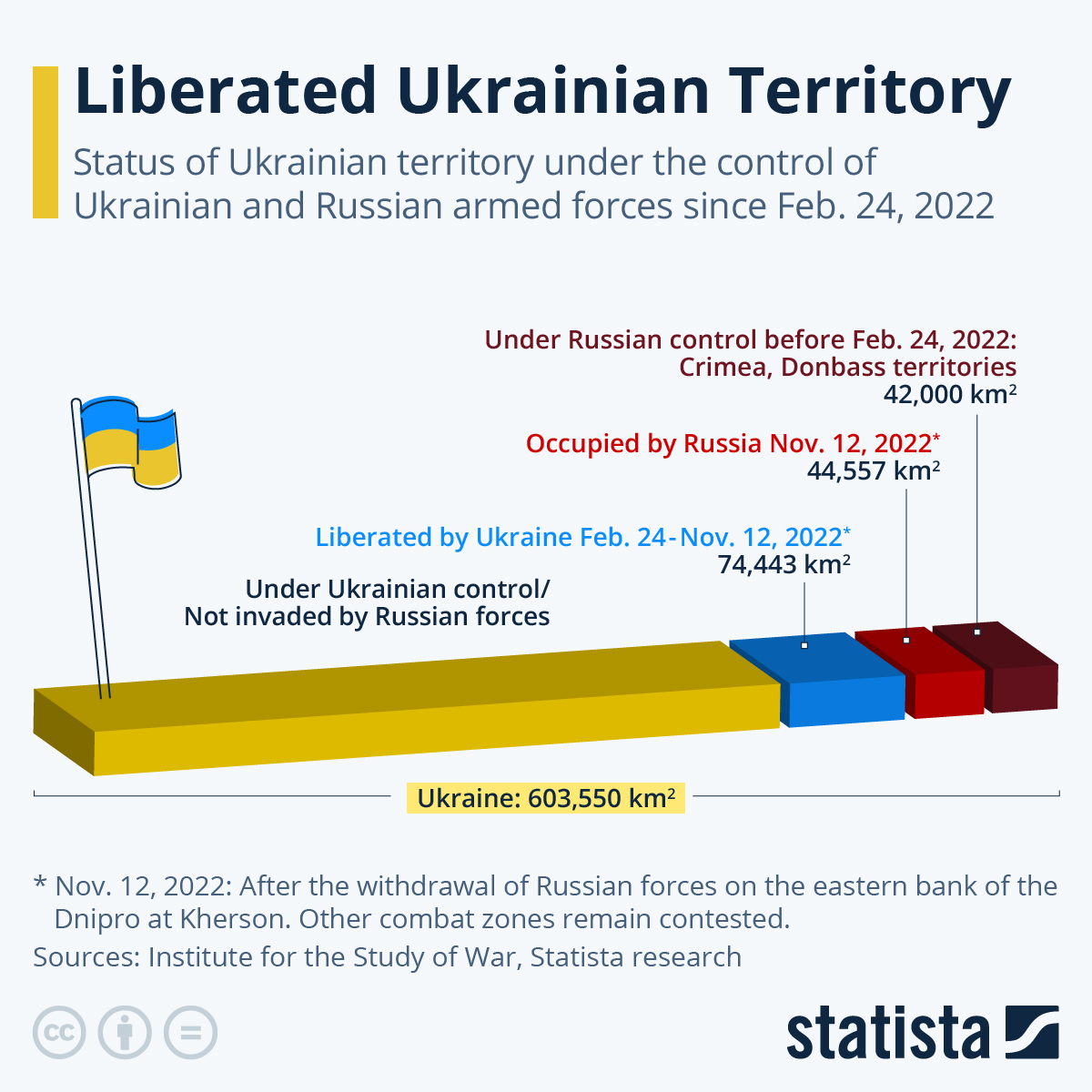
2.5: Two Hours to Moscow #
In the face of these serious setbacks, the Russians were keen to retake the initiative and show their population that they were still capable of achieving successes on the battlefield, launching new offensives in early 2023.
This plan was mostly a failure, with no significant changes on the battlefield or shifts in the balance of power, but Russia was able to claim one notable battlefield victory, the capture of a city in the Donetsk region called Bakhmut (also referred to by an older name, “Artemovsk”, by Russian sources).
The takeover of the city was lauded by the Russian press and its participants were labelled as heroes, but the interesting thing is,
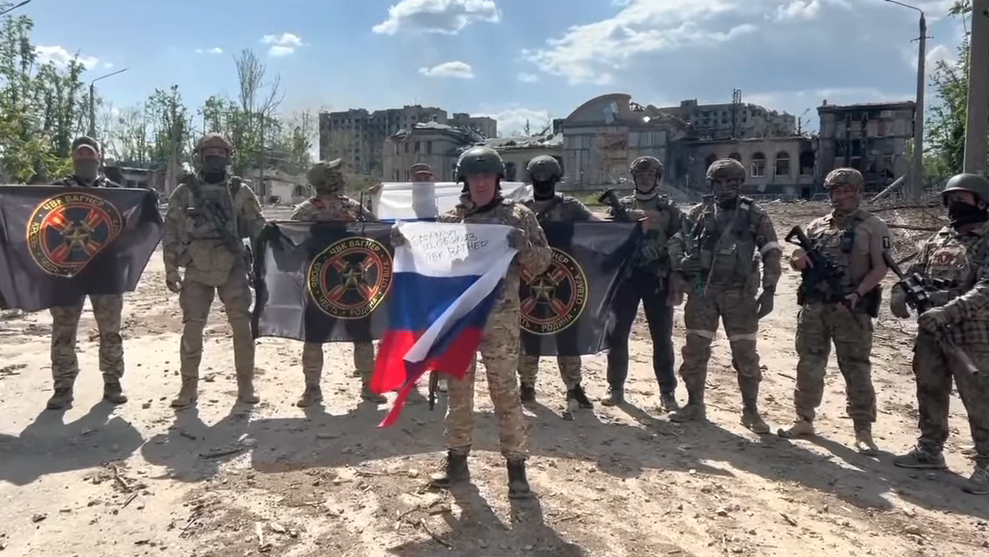
the soldiers behind this victory weren’t Russian troops.
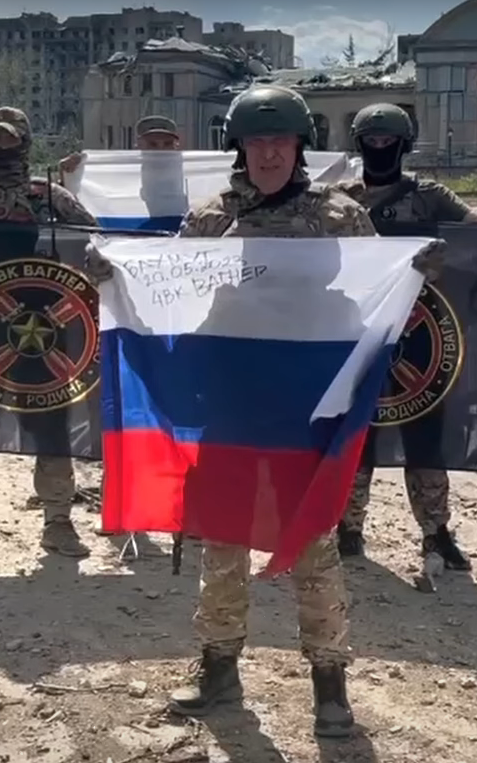
This is Yevegeny Prigozhin, he’s not a commander or even a member of the Russian military, he’s a businessman, and the soldiers next to him are from a once mysterious Private Military Company called the Wagner Group.
Wagner is an organisation that has been around for a long time, the group was reportedly founded in 2014 by Prigozhin and an ex-Spetsnaz agent known as Dmitry Utkin, the group participated in the early separatist conflicts in Donbas, but also other conflict regions of interest to Russia, specifically Syria, Libya, the Central African Republic and Mali.
For many years Wagner did not officially exist, Prigozhin denied any links to paramilitary activity and the group went mostly unacknowledged, in fact Wagner technically was never even a legal organisation because forming paramilitary groups is a crime in Russia, but it seems this group was allowed to operate to give the Kremlin an opportunity to pursue some of its military ambitions with plausible deniability.
However, with the invasion of Ukraine, the mask slipped, Prigozhin admitted his involvement with Wagner and the group began clearly working alongside Russian troops as a participant in the invasion.
But Wagner’s value didn’t just come from its arms length relationship with Kremlin, the group is also a valuable asset to the Russians because of its talent pool, being an organisation filled with battle hardened mercenaries, who don’t easily shy away from a fight or from swinging their favourite tool around: The Sledgehammer, which has become emblematic for the Organisation as a whole, put simply the group was ruthless towards its enemies and towards any potential traitors.
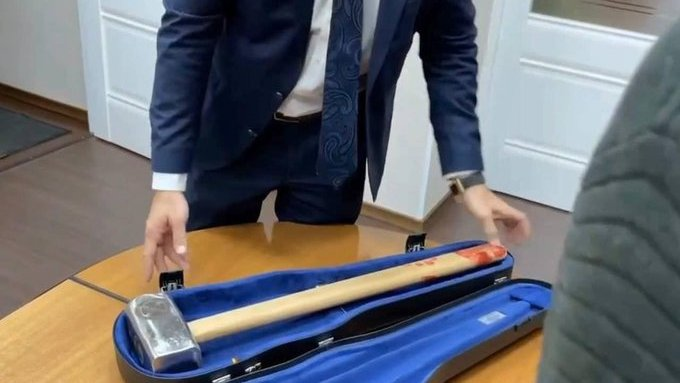
Wagner also acted as a source for disposable manpower as part of the war effort, with Prigozhin, an ex-criminal himself, recruiting prisoners to fight for the company, promising forgiven sentences for those who survived and warning that falling behind would be considered a death sentence, this combination of hardened mercenaries and disposable crooks created a force that was capable of achieving successes where regular Russian forces could only produce stagnation.
But being an extralegal group staffed by criminals, operating outside of the military’s control, Wagner was volatile and at odds with the rest of the invasion force, having a tighter bond to Prigozhin rather than the leader of their country.
During the capture of Bakhmut Prigozhin had a habit of posting angry rants to his social media sources, accusing Russian Generals of mismanaging the war and not providing his company with enough resources, and even after the end of the battle these rants continued, with Prigozhin accusing the Russian military of mining the route out of the city and even briefly “arresting” a Russian officer for shooting at one of his convoys. As more and more news of Prigozhin’s outbursts emerged it became clear that the Wagner Group was a powder keg, and that while his forces were aligned to the Kremlin, it wasn’t a cosy relationship.
To resolve this standoff, the Russian Defence Ministry issued an order demanding that the paramilitary forces of the war effort sign contracts with the Russian military, bringing them fully under government control, but this demand produced the exact opposite of what the Kremlin was hoping for, prompting Prigozhin to plan his boldest move yet.
After the Russian offensive died down, Ukraine responded with a new counter offensive in mid-2023 that also produced lacking results, but in this period, while most Russian forces were busy defending their front lines, Prigozhin decided to execute his plan.
Suddenly, on the early evening of July 23rd, Prigozhin delivered a furious speech on his Telegram account stating that the Russian government was lying to its people about the Ukraine conflict, noting that neither Ukraine or NATO had been planning any sort of attack on Russia, stating that Zelensky had been ready to negotiate, and even going as far as saying that the real cause for the invasion had been to enrich an “oligarchic clan” of “mentally ill scumbags”. He essentially demolished Russia’s entire narrative of an aggressive Ukraine and a Russia acting in self defence, and slammed Russia’s military leaders as a gang of crooks, I guess it takes one to know one.
Even after that, not many could have predicted that the “Wagnerites” would try to swing their sledgehammers at Putin’s head, but that’s exactly what happened.
In the early hours of July 24th, Wagner troops left their bases and crossed the border from the disputed territories of Donbas into Russia proper, sending a massive convoy towards Rostov city in what Prigozhin was calling a “march of justice”. Within hours the official state media of Russia (TASS) announced that criminal cases had been opened against Prigozhin and the Wagner group on charges of “mutiny”, and claimed that entry towards Rostov was being blocked by military checkpoints.
But these checkpoints completely failed to stop the Wagner advance, as in the morning Wagner troops entered the centre of Rostov city and took control of the Russian military headquarters there, which was also the control centre for the entire Ukraine war effort, an hour later, 4am GMT, footage emerged of Prigozhin himself at the headquarters with senior Russian military officials, threatening that if the Chief of the Russian General Staff Valery Gerasimov did not come to Rostov to meet with him, Prigozhin would go to Moscow, the unthinkable was confirmed, a rebel force had marched into a major Russian city and taken over without a fight, Wagner was launching a coup.
These do appear to be Elements of the Wagner Group outside of the Southern Military District Headquarters, but some of the Soldiers are also wearing “Rosgvardia” Patches and National Guard/Military Trucks can be seen which makes this Extremely Confusing. pic.twitter.com/hduk3lzBUO
— OSINTdefender (@sentdefender) June 24, 2023
Unsurprisingly Gerasimov didn’t show up, and it became clear that the Wagner forces were following through on their threat, while some soldiers remained in Rostov to secure control of the city the rest of the troops continued their convoy on the 12 hour drive to Moscow, by 5am GMT footage emerged of Wagner forces at the halfway point of the journey, Voronezh, and as more and more civilians posted footage to social media of the convoy passing along its route it became clear what the Russian authorities were up against, a patchwork of military trucks, civilian vehicles, and BMP armoured personnel carriers.
By this point, Vladimir Putin finally emerged to give a short 5 minute speech justifying the Ukraine war, accusing the Wagner forces of treason, and promising to “stabilise” the situation in Rostov-on-Don, the most this amounted to was a convoy of Kremlin-loyalist Chechens being sent to Rostov to retake the city, but they got stuck in a traffic jam… Yes, seriously.
A Column of the 141st Special Motorized Regiment also know as the “Kadyrovites” which were Ordered by the Head of the Chechen Republic, Ramzan Kadyrov to Deploy to the Rostov Region against Wagner PMC Forces appeared to have gotten Stuck in Traffic earlier today. pic.twitter.com/muITK9l7A7
— OSINTdefender (@sentdefender) June 24, 2023
Shortly after the speech, Prigozhin responded with a direct criticism of the Russian President:
As for the betrayal of the motherland, the president was deeply mistaken. We, the patriots of our homeland, we have fought and are fighting. All Wagner PMC fighters and no one is going to at the request of the president of the FSB or someone else to turn themselves in, because we don’t want the country to continue to live in corruption, deceit and bureaucracy.
When we were fighting in Africa, we were told that we needed Africa, and after that it was abandoned because they stole all the money that was supposed to go to help. When we were told we were at war with Ukraine, we went and fought. But it turned out that the supplies, the weapons, all the money that had been put into them was also being stolen.
And the bureaucrats are sitting there, saving them for themselves, just for the occasion, which came today, when someone goes to Moscow.
The steady progression of the convoy despite Putin’s clear stance against the mutiny made it clear that the Kremlin was paralysed, with its defences along the route only including troops from Russia’s National Guard who were unwilling or unable to attack the convoy, as the day progressed the Wagner forces were getting closer and closer to their target, reaching the Lipetsk region, 4 hours away from Moscow by midday (GMT), and as it became clear that this was a serious threat the Russian government organised a series of retaliations, preparing checkpoints equipped with grenade launchers on the outskirts of Moscow, ordering Wagner affiliated social media accounts to be blocked, and having roads dug up with excavators to block the routes available to the convoy.
BREAKING:
— Visegrád 24 (@visegrad24) June 24, 2023
The Wagner Group has now reached the Lipetsk region.
Moscow is only 4 hours away by car.
The Battle of Moscow could start this evening. pic.twitter.com/SBISoA56OK
⚡️Defensive positions being set up in Moscow according to local newspapers pic.twitter.com/iB1cNEkGrg
— War Monitor (@WarMonitors) June 24, 2023
⚡️VK (Russian social media) blocked the Wagner PMC group at the request of the Prosecutor General's Office of the Russian Federation
— War Monitor (@WarMonitors) June 24, 2023
By 4pm social media reports of Wagner Group reaching the Moscow Region had emerged, which matched with appearances on Google Maps of traffic jams in the region, showing that the convoy was roughly 2 hours away from Moscow city centre,
BREAKING:
— Visegrád 24 (@visegrad24) June 24, 2023
The first Wagner units have reached the Moscow region pic.twitter.com/A1ZwvDgYMF
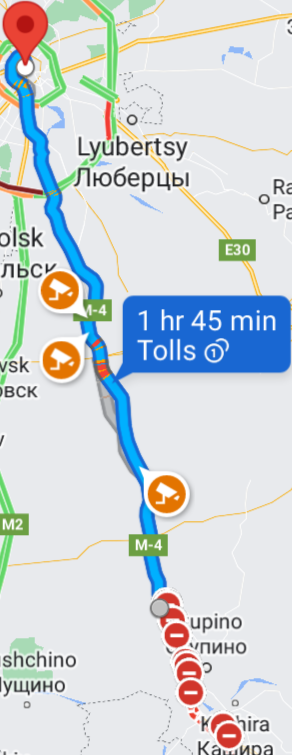
but it was this point that the tide began to turn, reports of Russian troops preparing to leave the front in Ukraine to defend Moscow and footage of Russian Marines pledging their loyalty to Putin appeared on social media
BREAKING:
— Visegrád 24 (@visegrad24) June 24, 2023
Some Russian units are pulling out of Ukraine and are returning to Russia in an effort to stop the advance of the Wagner Group
🇷🇺 Marines of the 155th brigade of the Pacific Fleet declared their loyalty to the oath and support of President Putin
— Zlatti71 (@Zlatti_71) June 24, 2023
The fighters of the NVO addressed the Supreme Commander with words of support and a call to suppress the turmoil.
The Pacific soldiers declared that they would… pic.twitter.com/0sQmUu108k
and around an hour later it emerged that Prigozhin had negotiated with a close ally of Russia, President Lukashenko of Belarus, on a deal to stop the convoy and send the mutineers back to base.
After over 12 hours of chaos, the coup attempt was over, and by 7pm Wagner was seen withdrawing from Rostov city, returning the area to Russian military control.
⚡️Situation in Rostov, hugs and farewells pic.twitter.com/hpU1C0326Y
— War Monitor (@WarMonitors) June 24, 2023
According to the Institute for the Study of War, a conflict analysis think tank, the furthest point the convoy reached was the village of Krasnoe, roughly an hour away from the Moscow city centre.
As a result we didn’t find out what Prigozhin was planning to do if he actually reached Moscow, did he want to outright remove Putin? Or keep him as a figurehead, someone who gets to call the shots on civilian politics but not the war effort? We’ll likely never know.
So looking at the aftermath of this we have 2 questions, why did Prigozhin agree to turn back, and why did Putin allow him to continue breathing?
Most likely, Prigozhin realised that unlike all the other areas Wagner’s convoy had reached, in Moscow there would be a real resistance to his forces, and Wagner wasn’t ready for a brutal prolonged battle in the middle of Russia’s capital.
As for Putin, he probably realised that having his troops in open combat with fighters that the Russian media had only months before been praising as heroic patriots for their actions in Bakhmut, would be bad PR.
But even with this peaceful resolution, a major leader in Russia’s forces going rogue and uprooting the Kremlin’s entire propaganda narrative was clearly a major blow to Russia’s image, something we can especially see from the damage control the Russian press attempted in the coup’s aftermath.
While at the time of the Bakhmut battle, Putin himself was quoted in the media congratulating Wagner for their “heroic” accomplishments and promising medals, after the mutiny attempt the Russian press tried to pull off a 180, presenting the narrative that while many Wagner fighters were true patriots, their efforts in Bakhmut actually weren’t very important or impressive on the grand scale of things, and reports of their effectiveness were just a “myth”.
Russian state TV is now doubting the effectiveness of Wagner which took much longer to "liberate a less important Bakhmut" in comparison to Mariupol". Hilarious.
— WarTranslated (Dmitri) (@wartranslated) July 1, 2023
The biggest irony is that this will actually work and in a few weeks, Wagner will be condemned by Russians who get… pic.twitter.com/dRExbADqC4
Although ultimately the frontlines in Ukraine ultimately didn’t change much during or immediately after the coup attempt, the credibility of the war effort was certainly undermined, an invasion sold to the Russian people as bringing stability, and ending a conflict, instead brought instability, and massively expanded that conflict.
That was a blow many suspected would be too much for the Kremlin, in the weeks after the mutiny many commentators speculated that Prigozhin was a dead man walking, 2 months later they were proven right.
In August 2023, Prigozhin published his first video after the mutiny, filming a Wagner recruitment pitch in Africa, and only days later on a return trip to Russia, his plane suddenly crashed, killing all on board.
The Kremlin presented this as a tragic aviation accident, while Wagner supporters claimed the plane had been purposefully shot down by Russian air defence, others speculated a bomb might have been detonated on board the plane itself, either way a loose end for Putin was tied up, and to us, well, let’s put it this way… It seems like Prigozhin became Icarus, flying too close to the sun.
While Russia managed to squash this particular crisis, what happens next, only time will tell.
Chapter 2 Summary #
-
The Russian invasion was split into 2 phases:
-
- Occupying Ukraine
-
- Annexing Donbas into Russia
-
-
The Russian leadership expected to accomplish both phases in only a few days or weeks
- Instead, Ukrainian forces held on to most of their territory, while Russian forces gained territory in the South and East of the country, Ukrainian forces pushed them back in the North and West
-
As a result of their losses, the Russians chose to drop Phase 1 and retreat from Northern and Western Ukraine
- Phase 2 was expanded to compensate, including the Kherson, Zaporizhia and Kharkiv regions
-
From this point the conflict fell into a stalemate of WW1 style trench warfare, with neither side making rapid gains
-
The stalemate ended when Ukraine’s September 2022 counter-offensive retook the Kharkiv region from Russian control
- Russia then annexed the Zaporizhia, Kherson and Donbas regions to try and secure the remaining regions they controlled
-
Russian authorities then declared a mobilisation of their population to compensate for their losses
- The response was split between hundreds of thousands enlisting and hundreds of thousands fleeing the country to avoid the draft
-
Since September 2022, the war has returned to stagnation
2.6: Possibilities #
Since the events of the mutiny, the overall battlefield has barely changed, despite many battles and lives lost.
Both sides have little to show for their roles in the conflict in 2023, Ukraine’s ambitions of driving the Russians into the Sea of Azov, retaking their lost southern lands and preparing for a march on Crimea, have fallen far short.
But in return, Russia’s goal of strangling Ukrainians into submission, forcing them to recognise the theft of territory they call home, has also failed, the result is a bleak future where no one knows how far off the horizon peace may be, when the bombs will stop falling, when loved ones will stop being called to sacrifice.
In this state, it seems the most likely outcome of the war will be a frozen conflict, the battle lines will stabilise, the shooting will stop or at least lessen, but no agreements or surrenders will be signed, just a limbo where neither force can dislodge the other, an uneasy peace with no true resolution.
But both combatants are playing the long game, believing that at some point there will be another curveball event:
Russia hopes that the political will of Ukraine’s allies in Europe and the US will falter, causing the weapons supplies to run out and the road to securing their occupation to open.
Ukraine is hoping that before that could happen, Russians will realise how much they are wasting dying for shattered colonies and turn on the leaders sending them to the front.
These curveballs are possible, the Wagner Mutiny paralysed and almost toppled the stability of the Kremlin, with Prigozhin and his grunts showing the depth of the discontent some of Russia’s warriors have for their commanding officers; While in the US, there is a serious prospect of a former President sympathetic to the Kremlin returning to power, cutting Ukraine off from its strongest supporter and forcing Europeans to choose whether or not to take up the lead and sacrifice more to fuel Ukraine’s cause, or give way to a resurgent Russia.
In the end the question is simple, will either side break? And if so, who breaks first?
This war has seen the emergence, or resurgence, of many competing national ideas, which are not only territorial, but ideological; The state of the war, either stagnation or destruction, will decide whose ideas will shape the future of Ukraine, Russia, and maybe other nations too, how these countries navigate their challenges could define our future.
With so many unknowns, we can’t tell you what the answer to these questions will be, or which of these ideas will triumph, we are not military experts, only writers and researchers with a keen eye for dissecting narratives, so we can only wait and see what the future holds, but we’ll do our best to inform, and promote truth as best we see it over simplistic, romantic or malicious propaganda lines. Just be warned; It will get messy.
Until next time, thank you for reading MEGA.
Sources for Episode 1: The Birth of Ukraine #
Chapter 1. Buildup #
Ukrainian People’s Republic #
Formation #
Ukrainian Wikipedia - via Wayback Machine:
“Ukrainian Central Council to the Ukrainian people, in Ukraine and abroad” https://web.archive.org/web/20210826113658/https://uk.wikisource.org/wiki/%D0%9F%D0%B5%D1%80%D1%88%D0%B8%D0%B9_%D0%A3%D0%BD%D1%96%D0%B2%D0%B5%D1%80%D1%81%D0%B0%D0%BB_%D0%A3%D0%BA%D1%80%D0%B0%D1%97%D0%BD%D1%81%D1%8C%D0%BA%D0%BE%D1%97_%D0%A6%D0%B5%D0%BD%D1%82%D1%80%D0%B0%D0%BB%D1%8C%D0%BD%D0%BE%D1%97_%D0%A0%D0%B0%D0%B4%D0%B8
Russian Recognition #
Institute of History of Ukraine:
“TEMPORARY INSTRUCTIONS TO THE GENERAL SECRETARIAT (1917)”
Declaration of Independence #
Soviet History:
“Ukrainian Declaration of Independence”
Union with West Ukraine #
Central State Archives of Higher Authorities and Administration of Ukraine - via Wikimedia:
“Універсал Злуки”
West Ukrainian Territory #
Wikimedia - by Wikimedia user Spiridon Ion Cepleanu:
“West Ukraine 1918”
https://commons.m.wikimedia.org/wiki/File:West-Ukraine_1918.jpg
Licence: CC-BY-SA 3.0
The War in 1919 #
Archive.org:
“Ukraine : a history by Orest Subtelny”
https://archive.org/details/ukrainehistory00subt_0/page/358/mode/2up
Editor’s Note: Ukrainian Proto-States and Notes #
Ukrainian Wikipedia:
“Українська революція (1917—1921) - Державні утворення, військові формування на території України у 1917—1921 роках”
(translates as “Ukrainian Revolution (1917-1921) - State formations, military formations in Ukraine in 1917-1921”)
Notes:
-
The Crimean People’s Republic, Kuban People’s Republic, were proclaimed to be autonomous parts of the Russian Soviet Republic
-
These republics attempted to unite with the Ukrainian Soviet Republic, but were defeated by other factions before doing so, both of these territories ended up joining the Russian Soviet
-
Crimea was transferred to the Ukrainian Soviet in the 1950s, while the Kuban region was one of the few territories claimed as part of Ukraine that didn’t end up in the Ukrainian Soviet in the future
-
The Donetsk-Kryvyi Rih Soviet Republic, Tavrida Soviet Socialist Republic, Kuban Soviet Republic and Kuban-Black Sea Soviet Republic were proclaimed to be autonomous parts of the Russian Soviet Republic
-
These republics didn’t attempt to join with the Ukrainian Soviet, but later ended up as part of it after the war, they existed either as wartime proxies or as local projects not supported by the USSR central government
-
The Galician Socialist Soviet Republic and Bessarabian Soviet Socialist Republic were proclaimed to be their own independent Republics
-
These territories seemingly were supposed to be their own Soviet Republics as part of the USSR, but they ended up as part of other countries outside the USSR after the war, until they were integrated into the Ukrainian Soviet in the 1930s and 40s
-
The “Republic of Gulyai-Pole” was the Black Army territory, also known as “Makhnovia” or the “Free Territory”
-
Makhnovia held alliances with some factions during the war, but didn’t have plans to unite with any of them, its territory ended up as part of Soviet Ukraine
-
The other territories were proclaimed with a Ukrainian identity and most had plans to unite with the UPR or WUPR, but were prevented from doing so by the events of the war
There were also 2 areas of what is now far-eastern Russia that had Ukrainian settlers, known to Ukrainians as the Grey and Green Wedges, Ukrainians there briefly tried to form their own Ukrainian Republics before being defeated by the Soviets:
https://bigthink.com/strange-maps/ukraine-russia-land-claims/
Information on these 2 statelets can be found on Ukrainian wikipedia under the titles “Український національний рух на Сірому Клині (1917-1921)” (Ukrainian National Movement on the Gray Wedge (1917-1921) and the section of the “Зелений Клин” article titled “Керівники Зеленої України” (Green Wedge - Leaders of Green Ukraine):
Soviet alliance with Germany #
Britannica:
“German-Soviet-Nonaggression-Pact”
https://www.britannica.com/event/German-Soviet-Nonaggression-Pact
(specific sections)
The OUN #
Wikipedia:
“Act of restoration of the Ukrainian state”
https://en.wikipedia.org/wiki/Act_of_restoration_of_the_Ukrainian_state
(text of declaration)
(image of declaration)
CIA Reading Room:
“Code Name PBCRUET”
https://www.cia.gov/readingroom/docs/AERODYNAMIC%20%20%20VOL.%201_0004.pdf
“Cold War Allies: The Origins of CIA’s Relationship with Ukrainian Nationalists”
Wikimedia - uploaded by Wikimedia user “Sofosbjörn”:
“Ukrayins’ka Povstans’ka Armiya (poster)”
https://commons.wikimedia.org/wiki/File:Ukrayins%27ka_Povstans%27ka_Armiya_(poster).jpg
Licence: CC-BY-SA 4.0
Indigenisation and Russification #
English Wikipedia:
“Korenizatsiia - Against Great-Russian chauvinism”
(specific section)
https://en.wikipedia.org/wiki/Korenizatsiia#Against_Great-Russian_chauvinism:~:text=Within%20the%20(minority,of%20Nationalities.
Russian Wikipedia:
“Indigenization - Termination of indigenization”
(specific section)
The Plans of Meshkov #
LB:ua:
“Crimea should be Ukrainian, but without bloodshed.” How Ukraine preserved the peninsula 25 years ago”
https://lb.ua/news/2020/07/16/461879_krim_maie_buti_ukrainskim_ale_bez.html
(relevant sections)
Ukraine’s Modern Divisions #
The Washington Post - via Wayback Machine:
“This one map helps explain Ukraine’s protests”
(specific sections)
Wikimedia - by Wikimedia user “Vasyl` Babych”:
“The second round of 2010 by districts” (Ukrainian Election Results)
Licence: CC-BY 3.0
OSCE:
“Yanukovych Wins Ukraine’s Presidential Election”
(specific section)
Yanukovytch’s Ambitions #
Kyiv Post - via Wayback Machine:
“Yanukovych: Ukraine will remain a neutral state”
https://web.archive.org/web/20100121145322/http://www.kyivpost.com/news/politics/detail/56539
UNIAN:
“Yanukovych imagines how he signs law on Russian language”
https://www.unian.info/politics/261616-yanukovych-imagines-how-he-signs-law-on-russian-language.html
Kyiv Post:
“Yanukovych signs language bill into law”
Bloomberg - via Wayback Machine:
“Yanukovych Drives Ukraine Toward EU as Russia Gas Deal Looms”
Rejection of EU agreement #
Russian threats #
Reuters (Relevant Stakeholder(s): The Woodbridge Company):
“Putin warns Ukraine over Europe ambitions”
https://www.reuters.com/article/us-russia-ukraine-putin-idUSBRE98I0WB20130919
Ukraine’s response #
The Guardian (Relevant Stakeholder(s): Scott Trust Limited)
“Ukraine suspends talks on EU trade pact as Putin wins tug of war”
https://www.theguardian.com/world/2013/nov/21/ukraine-suspends-preparations-eu-trade-pact
(specific sections)
Maidan-Self Defence rejects Yanukovych-Opposition deal #
RBC Ukraine - via Wayback Machine:
“The right sector “is dissatisfied with the agreement with Yanukovych”
Euromaidan Press:
“Parasyuk to run for parliament”
https://euromaidanpress.com/2014/09/20/parasyuk-to-run-for-parliament/
(specific section)
Yanukovych Impeachment and Aid Request #
Social Science Research Network - via Wayback Machine:
“The Crimea Crisis – An International Law Perspective”
https://web.archive.org/web/20210925174058/https://papers.ssrn.com/sol3/papers.cfm?abstract_id=2520530 (PDF Page 9)
BBC News (Relevant Stakeholder(s): UK State)
“Ukraine’s Yanukovych asked for troops, Russia tells UN”
https://www.bbc.com/news/world-europe-26427848
European Journal of International Law:
“Yanukovych Confirms He Invited Russian Intervention”
https://www.ejiltalk.org/yanukovych-confirms-he-invited-russian-intervention/
AP - via Wayback Machine:
“Ukraine’s Ousted President Hopes for Crimea’s Return”
The Little Green Men #
BBC News (Relevant Stakeholder(s): UK State)
““Little green men” or “Russian invaders”?”
https://www.bbc.com/news/world-europe-26532154
(relevant section)
Liga.net:
“Putin: Ukrainian troops in Crimea were blocked by Russian troops”
https://news.liga.net/politics/video/putin_ukrainskikh_voennykh_v_krymu_blokirovali_nashi_voennye
(relevant section)
Crimea Referendum #
Question and Results #
Wikipedia:
“2014 Crimean status referendum - Official results”
https://en.wikipedia.org/wiki/2014_Crimean_status_referendum#Official_results
Kyiv Post:
“Two choices in Crimean referendum: yes and yes”
Recognition of Results #
Wikimedia - by Wikimedia users “Canuckguy” and “Spesh531”:
“Countries recognizing Russian annexation of Crimea”
https://commons.wikimedia.org/wiki/File:Recognition_of_Crimean_Referendum.svg
Licence: CC-BY-SA 3.0
US Agency for Global Media:
“Ukraine political attitudes split, Crimeans turning to Russian sources for news”
Bloomberg - via Wayback Machine:
“One Year Later, Crimeans Prefer Russia”
Euromaidan #
Far Right Presence #
The Washington Post:
“A ghost of World War II history haunts Ukraine’s standoff with Russia”
BBC News (Relevant Stakeholder(s): UK State)
“Ukraine crisis: Does Russia have a case?”
https://www.bbc.co.uk/news/world-europe-26415508
(specific section)
The Guardian (Relevant Stakeholder(s): Scott Trust Limited)
“Ukrainian far-right group claims to be co-ordinating violence in Kiev”
https://www.theguardian.com/world/2014/jan/23/ukrainian-far-right-groups-violence-kiev-pravy-sektor
(specific section)
Uprising #
Wikipedia:
“2014 Euromaidan regional state administration occupations”
https://en.wikipedia.org/wiki/2014_Euromaidan_regional_state_administration_occupations
The Globe and Mail - via Wayback Machine:
(specific sections)
International Business Times:
“Ukraine Facing Civil War: Lviv Declares Independence from Yanukovich Rule”
UNIAN:
“The People’s Council of the Troia Oblast banned PR and the Communist Party of Ukraine”
https://www.unian.ua/kyiv/880167-narodna-rada-troeschini-zaboronila-pr-i-kpu.html
Wikimedia - by Wikimedia user “Lvivske”:
“Euromaidan RSA occupations”
https://commons.wikimedia.org/wiki/File:Euromaidan_RSA_occupations.png
Licence: CC-BY-SA 3.0
New Government #
GeoPolitical Forecasts:
“Yanukovych’s removal was unconstitutional”
https://gpforecasts.wordpress.com/2014/02/28/yanukovychs-removal-was-unconstitutional/
Kyiv Post:
“Rada dismisses Constitutional Court judges appointed from its quota”
Anti Maidan Uprising #
Wikimedia - by Wikimedia user “RGloucester”:
“2014 pro-Russian unrest in Ukraine”
https://commons.wikimedia.org/wiki/File:2014_pro-Russian_unrest_in_Ukraine.svg
Licence: CC-BY-SA 3.0
Kyiv Post:
“Kharkiv settles down, while pro-Russian separatists still hold buildings in Luhansk, Donetsk”
(specific section)
Extremists in Volunteer Battalions #
Science Norway:
“This is where Neo-Nazi foreign fighters fought alongside communists”
Views on the Maidan #
Ukrainian Policy - via Wayback Machine:
“Southeast Statistics”
(specific sections)
Combat Readiness of Ukrainian forces, emergence of “volunteers” #
IAI:
“Heroes or Villains? Volunteer Battalions in Post-Maidan Ukraine”
https://www.academia.edu/11479414/Heroes_or_Villains_Volunteer_Battalions_in_Post_Maidan_Ukraine
Maidan groups refusal to disarm #
France24 (Relevant Stakeholder(s): French State):
“Kiev’s far-right groups refuse to disarm”
(relevant section)
Russian recognition of elected government #
The Moscow Times (Relevant Stakeholder(s): Sanoma Corporation)
“Russia to Recognize Ukraine Election Results, Says Lavrov”
Maidan Aftermath #
The Minsk Agreements - Text #
OSCE:
Minsk 1 (in Russian)
https://www.osce.org/files/f/documents/a/a/123258.pdf
Minsk 2 (in Russian)
https://www.osce.org/files/f/documents/5/b/140221.pdf
Wikipedia:
Minsk 1 (translated to English)
https://en.wikipedia.org/wiki/Minsk_agreements#Minsk_Protocol
Minsk 2 (translated to English)
https://en.wikipedia.org/wiki/Minsk_agreements#Minsk_II,_February_2015
Minsk parties ignore their own agreement #
Kyiv Post:
“Quieter, but guns of war still not silent, on first day of cease-fire in Donetsk”
(relevant section)
Euromaidan Press:
“Dmytro Yarosh: ‘Right Sector’ to fight until complete liberation of Ukraine from Russian occupants”
(relevant section)
NATO Trainers in Ukraine #
Voice of America (Relevant Stakeholder(s): US State):
“US Forces Launch Ukraine Military Training”
https://www.youtube.com/watch?v=EPmIWTZJrnY
Zelensky’s Russia Approach #
Pravda Ukraine:
“Zelenskyi on the war in Donbas: Although he is ready to negotiate with the bald devil”
https://www.pravda.com.ua/news/2018/12/26/7202291/
Atlantic Council:
“Russia as aggressor, NATO as objective: Ukraine’s new National Security Strategy”
Chapter 2. Catchup #
Russian military’s “end of Phase One” #
CGTN (Relevant Stakeholder(s): Chinese State):
“Russia says main tasks of first stage of ‘special military operation’ achieved”
https://www.youtube.com/watch?v=_agGQ9U97PA
CNN:
“Russia says first phase of war is over as its advances in Ukraine appear to have stalled”
(specific quote)
Referendum plans in Eastern Ukraine #
Yahoo:
“Russia wants to annex Kharkiv Oblast, unveils flag for region with imperial symbols – ISW”
https://www.yahoo.com/video/russia-wants-annex-kharkiv-oblast-082800632.html
Zona Media:
“Russian-appointed authorities of Zaporizhia region announced a referendum on “reunification””
https://zona.media/article/2022/08/08/svodka-166
(specific section)
Caspian News:
“Kremlin Reveals Plans to Hold Referendum on Joining Russia in Kherson”
TASS (Relevant Stakeholder(s): Russian State):
“The referendum on the entry of the DPR into Russia will be held from 23 to 27 September”
https://tass.ru/mezhdunarodnaya-panorama/15808407
Times of Israel:
“Leader of east Ukraine separatist region says it may hold vote on joining Russia”
Russification in Eastern Ukraine #
TASS (Relevant Stakeholder(s): Russian State):
“About 500 in Kharkov Region get Russian passports — local official”
https://tass.com/world/1509303
Ruptly TV (Relevant Stakeholder(s): Russian State):
“Ukraine: Melitopol residents queue for Russian SIM-cards”
RIA (Relevant Stakeholder(s): Russian State):
“Kherson region moves to the ruble zone”
https://ria.ru/20220428/rubl-1785852369.html
Views on NATO #
Statista:
“Survey on perception of NATO membership in Sweden 2014-2022”
https://www.statista.com/statistics/660842/survey-on-perception-of-nato-membership-in-sweden/
Business Insider:
“Finland’s people now strongly back joining NATO, poll says, a massive political shift that would enrage Russia”
The National Interest:
“NATO is Obsolete”
https://nationalinterest.org/feature/nato-obsolete-25167
Ukrainian Counter Offensive in Kharkiv #
BBC News (Relevant Stakeholder(s): UK State)
“Ukraine war: Russians ‘outnumbered 8-1’ in counter-attack”
https://www.bbc.co.uk/news/world-europe-62874557
Russian Defence Ministry:
“Statement by the official representative of the Russian Ministry of Defense”
https://function.mil.ru/news_page/country/more.htm?id=12437675@egNews
(specific quote)
Escalations after Ukrainian counteroffensive #
Pro-Russian Referendums #
TASS (Relevant Stakeholder(s): Russian State):
“DPR, LPR, liberated zone of Zaporozhye, Kherson Regions embark on referendum vote”
https://tass.com/politics/1512233
“How DPR, LPR, Kherson, Zaporozhye voted for joining Russia”
https://tass.com/politics/1514667
(specific quotes)
Donetsk: #
Luhansk: #
Zaporizhzhia: #
Kherson: #
Unification of Eastern Ukraine with Russia #
TASS (Relevant Stakeholder(s): Russian State):
“Treaties on accession of Donbass and other liberated territories to Russia signed”
https://tass.com/politics/1516023
Russian Mobilisation #
TASS (Relevant Stakeholder(s): Russian State):
“Partial mobilization in Russia to begin today”
https://tass.com/politics/1511097
Associated Press:
“Reservists’ mobilization continues in Russia”
https://www.youtube.com/watch?v=-GQ3-Z1l4dQ
“Russians flee, protest as mobilization announced”
https://www.youtube.com/watch?v=5ImK-4YjgmQ
DW (Relevant Stakeholder(s): German State):
“Russia’s partial mobilization: Conscripts report call-up chaos”
https://www.dw.com/en/russias-partial-mobilization-conscripts-report-call-up-chaos/a-63301779
(specific quote)
Exodus from Russia #
Finnish Border Guard:
“Traffic at Finland’s eastern border has remained busy since last Wednesday.”
https://twitter.com/rajavartijat/status/1574376900256055296
Daily Mail:
“Russians continue to stream across the border into Georgia”
(specific quote)
France24 (Relevant Stakeholder(s): French State):
“‘I don’t want to die’: Exodus from Russia after Putin’s call-up for Ukraine war”
Lentaru:
“tickets for direct flights to Istanbul and Yerevan were sold out”
https://twitter.com/lentaruofficial/status/1572492156790620160
Forbes RU:
“About 700,000 citizens left Russia after September 21”
https://www.forbes.ru/society/478827-rossiu-posle-21-sentabra-pokinuli-okolo-700-000-grazdan
(relevant section)
Yahoo:
“Mobilisation in Russia: more than 200,000 Russians flee to Kazakhstan”
https://news.yahoo.com/mobilisation-russia-more-200-000-072332882.html
Attacks on Recruitment Offices #
Daily Mail:
“Man sets fire to Uryupinsk office amid military enlistment”
https://www.youtube.com/watch?v=xks_SDnEUoM
News AU:
“Military recruitment office set on fire near Moscow”
https://www.youtube.com/watch?v=saDTW-1_IOI
The Telegraph:
“Russian military recruitment centres targeted with Molotov cocktails in spate of activist attacks”
https://www.youtube.com/watch?v=htDukC2t0F0
Drafting Criteria #
Sky News Australia (Relevant Stakeholder(s): News Corp):
“Kremlin acknowledges partial mobilisation is not going according to Putin’s plan”
(relevant sections)
“Reservists and Veterans Only” #
Elderly and disabled being called up #
Protest Consequences #
Reuters (Relevant Stakeholder(s): The Woodbridge Company):
“Russia fights back in information war with jail warning”
Official Criticism #
Russia Today (Relevant Stakeholder(s): Russian State) - via Wayback Machine:
“Top Russian MP blasts Defense Ministry over Ukraine”
(link removed from public sources due to eu regulations blocking reproduction of rt content)
(specific sections)
(link removed from public sources due to eu regulations blocking reproduction of rt content)
(link removed from public sources due to eu regulations blocking reproduction of rt content)
Frozen Conflict #
BBC News (Relevant Stakeholder(s): UK State)
“Ukraine fighting is deadlocked, spy chief Kyrylo Budanov tells BBC”
https://www.bbc.co.uk/news/world-europe-64109024
Ukrainian recovered territory #
Statista:
“Liberated Ukrainian Territory”
https://www.statista.com/chart/28748/ukraine-territory-control-status-distribution/
(Article based on data from the Institute for the Study of War:
https://www.understandingwar.org/backgrounder/russian-offensive-campaign-assessment-november-13)
The Wagner Mutiny #
Background #
Russian Criminal Code - via Wayback Machine:
“Chapter 34. Crimes Against Peace and Mankind’s Security”
(specific section)
Reuters (Relevant Stakeholder(s): The Woodbridge Company):
“Russia’s Prigozhin admits link to Wagner mercenaries for first time”
The Times:
“Wagner Group sends EU Parliament a message with ‘bloodied’ hammer”
Meduza:
“Prigozhin’s criminal past, straight from the source A complete translation of one of the court documents from the case that sent ‘Putin’s chef’ to prison, four decades ago”
https://meduza.io/en/feature/2021/06/29/prigozhin-s-criminal-past-straight-from-the-source
BBC News (Relevant Stakeholder(s): UK State):
“Wagner Group: Head of Russian mercenary group filmed recruiting in prison”
https://www.bbc.co.uk/news/world-europe-62911618
(specific section)
“Ukraine war: Wagner detains Russian officer over ‘drunk’ attack”
https://www.bbc.co.uk/news/world-europe-65809844
“Ukraine war: Russia moves to take direct control of Wagner Group”
https://www.bbc.co.uk/news/world-europe-65871232
Kyiv Independent:
“Prigozhin accuses Russian Defense Ministry of placing mines along Wagner exit routes from Bakhmut”
https://kyivindependent.com/prigozhin-says-russian-defense-ministry-laid-mines/
The Guardian (Relevant Stakeholder(s): Scott Trust Limited):
“Wagner chief accuses Moscow of lying to public about Ukraine”
Beginning of Wagner’s Mutiny #
TASS (Relevant Stakeholder(s): Russian State) - via Wayback Machine:
“Criminal case opened against Wagner head amid threat of escalating confrontation — FSB”
https://web.archive.org/web/20230623233418/https://tass.com/russia/1637455
TASS (Relevant Stakeholder(s): Russian State):
“Russian security service starts mutiny probe after statements by Prigozhin — committee”
https://tass.com/russia/1637425
“Checkpoints established near Southern Military District headquarters in Rostov-on-Don”
https://tass.com/russia/1637457
“Car traffic on M-4 highway in Rostov Region blocked, cars being turned back”
https://tass.com/russia/1637463
OSINTdefender - via Twitter:
“These do appear to be Elements of the Wagner Group outside of the Southern Military District Headquarters”
https://twitter.com/sentdefender/status/1672429891499749376
Intel Slava Z - via Telegram:
“The network has footage of the arrival of Wagner PMC at the headquarters of the Southern Military District in Rostov”
Mutiny halfway point #
Military Informant - via Telegram:
“Column of the Wagner PMC in the Voronezh region.”
https://t.me/milinfolive/102560
Kremlin:
“Address to citizens of Russia”
http://en.kremlin.ru/events/president/news/71496
War Monitor - via Twitter:
“A column of armored personnel carriers BTR-82A of the Chechen “Akhmat” near Rostov.”
https://twitter.com/WarMonitors/status/1672597743410225152
“Photos of the Wagner convoy that’s heading in the direction of Moscow currently in Lipetsk”
https://twitter.com/WarMonitors/status/1672577758663172098
“Convoy of Wagner PMC is traveling through the Lipetsk region on their way to Moscow.”
https://twitter.com/WarMonitors/status/1672599456410136577
“Defensive positions being set up in Moscow according to local newspapers”
https://twitter.com/WarMonitors/status/1672578596471296007
“VK (Russian social media) blocked the Wagner PMC group at the request of the Prosecutor General’s Office of the Russian Federation”
https://twitter.com/WarMonitors/status/1672584277702131713
Meduza:
“In the Lipetsk region, where the mercenaries of the Wagner ChVK are located, excavators dug up the highway”
OSINTdefender - via Twitter:
“A Column of the 141st Special Motorized Regiment also know as the “Kadyrovites” which were Ordered by the Head of the Chechen Republic, Ramzan Kadyrov to Deploy to the Rostov Region against Wagner PMC Forces appeared to have gotten Stuck in Traffic earlier today.”
https://twitter.com/sentdefender/status/1672682797536800770
Visegrád 24 - via Twitter:
“The Wagner Group has now reached the Lipetsk region. Moscow is only 4 hours away by car. The Battle of Moscow could start this evening.”
https://twitter.com/visegrad24/status/1672584398774960128
“BREAKING: The first Wagner units have reached the Moscow region”
https://twitter.com/visegrad24/status/1672635807516041219
“BREAKING: Some Russian units are pulling out of Ukraine and are returning to Russia in an effort to stop the advance of the Wagner Group”
https://twitter.com/visegrad24/status/1672638686943428608
Intel Slava Z - via Telegram:
“Most of the sites of information publications of the Patriot media group have been blocked.”
Zlatti71 - via Twitter:
“Marines of the 155th brigade of the Pacific Fleet declared their loyalty to the oath and support of President Putin”
https://twitter.com/djuric_zlatko/status/1672638644136427522
End of the Mutiny #
teleSUR English (Relevant Stakeholder(s): Venezuelan State):
“Lukashenko Strikes Deal With Wagner Group, Prigozhin Retreats”
War Monitor - via Twitter:
“Situation in Rostov, hugs and farewells”
https://twitter.com/WarMonitors/status/1672677069539483648
“Wagner in Rostov: “Boys, let’s load up, let’s go home!"”
https://twitter.com/WarMonitors/status/1672669508316585984
“Military police vehicles appeared near the headquarters of the Southern Military District in Rostov, RIA Novosti correspondent reports.”
https://twitter.com/WarMonitors/status/1672679835548676096
Institute for the Study of War:
“RUSSIAN OFFENSIVE CAMPAIGN ASSESSMENT, JUNE 24, 2023”
https://www.understandingwar.org/backgrounder/russian-offensive-campaign-assessment-june-24-2023
(specific section)
Aftermath #
TASS (Relevant Stakeholder(s): Russian State):
“Putin congratulates Wagner assault teams with liberation of Artyomovsk — Kremlin”
https://tass.com/defense/1620655
War Monitor - via Twitter:
“Russian state TV is now doubting the effectiveness of Wagner which took much longer to “liberate a less important Bakhmut” in comparison to Mariupol”. Hilarious.”
https://twitter.com/wartranslated/status/1675058889249681409
Possibilities #
Business Insider:
“Only 0.2% of Ukraine’s landmass has changed hands in 2023, report says, despite thousands dead and billions of dollars spent”
DW (Relevant Stakeholder(s): German State):
“Ukraine’s counteroffensive: Goals, opportunities, risks”
https://www.dw.com/en/ukraines-counteroffensive-goals-opportunities-risks/a-65467835
(specific sections)
Statista:
“Total bilateral aid commitments to Ukraine between January 24, 2022 and May 31, 2023, by type and country or organization”
https://www.statista.com/statistics/1303432/total-bilateral-aid-to-ukraine/
Changelog #
Edit 1 - 12/09/24 - Fixed a broken quotation, minor formatting improvements
